The Historical Mile of Nuremberg (Historische Meile Nürnberg) is a hiking route that passes through the most significant historical sites of the city.
The route "Historical Mile of Nuremberg" was created as part of the celebration of the 950th anniversary of the city of Nuremberg in 2000. The route informs about the historical, architectural, artistic and cultural past of Nuremberg, as well as gives a brief idea of the main attractions of the medieval city.
The main part of the route passes through the Old City of Nuremberg, surrounded by a former city wall with fortifications. Several places (points) of the mile are located outside the old town.
Although most of the sights of Nuremberg were destroyed or damaged during the Second World War, nevertheless, today they are restored and restored and, as before, have medieval features.
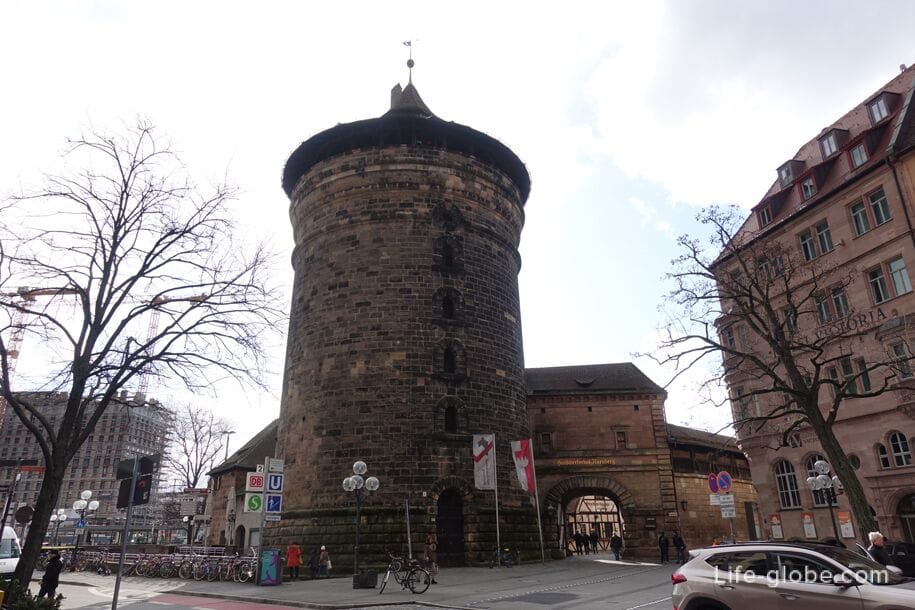
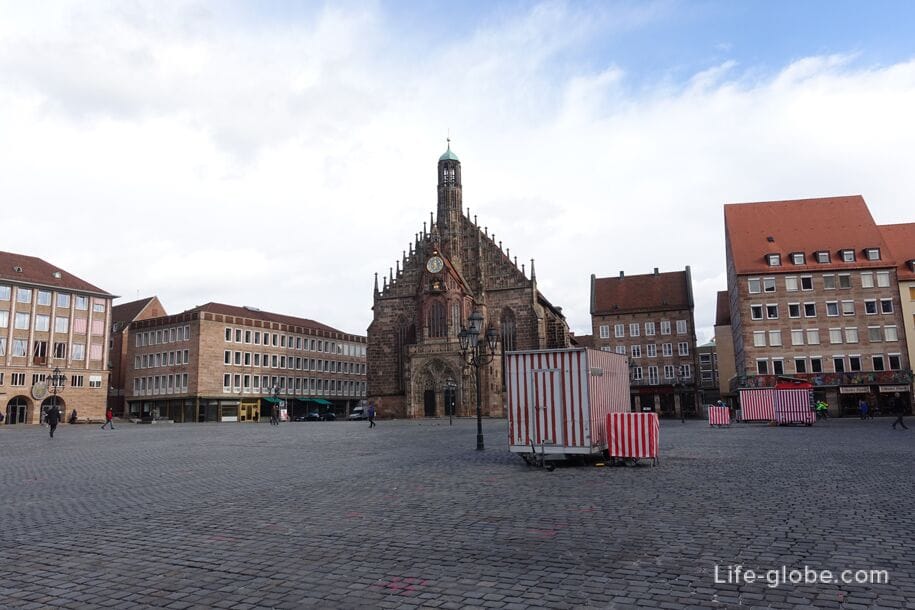

Points (places) The historical Mile of Nuremberg
Nuremberg City Wall
The last city wall with fortifications surrounding the old city of Nuremberg was built by 1400 and had a length of 5 kilometers.
Today, the fortress wall of Nuremberg is one of the most important artistic and architectural monuments in the city. There are gates and towers in the wall, some of which are used by organizations and individuals. Behind, on and in front of the wall, as well as in the moat that has been preserved in places, now there are mainly pedestrian paths available for public use, and the moat itself is largely designed as a park. The former mighty bastions to the west and north of Nuremberg Castle are arranged as a castle garden and are usually accessible during the warmer months.
The Nuremberg Wall includes some of the most important and interesting sections. Learn more about the Nuremberg wall and fortifications...
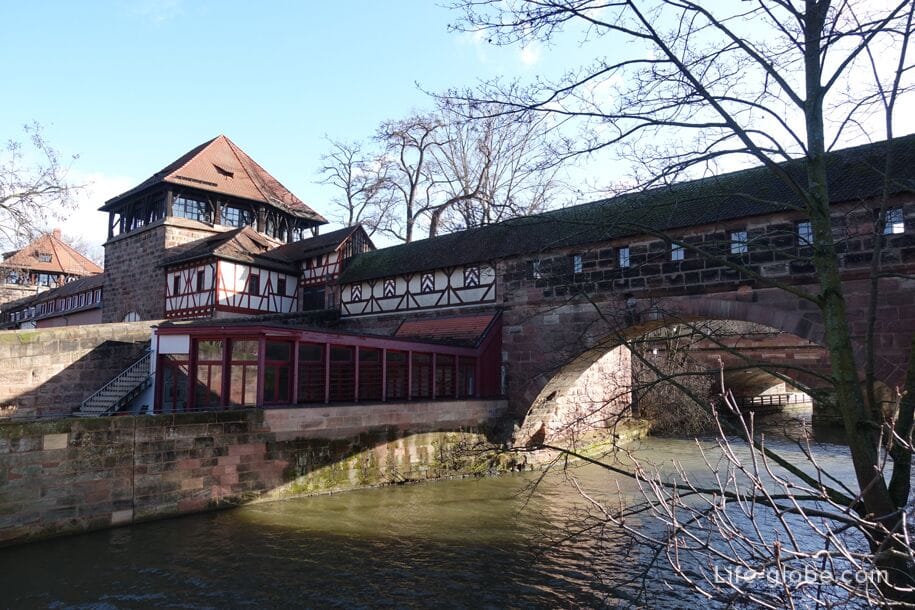
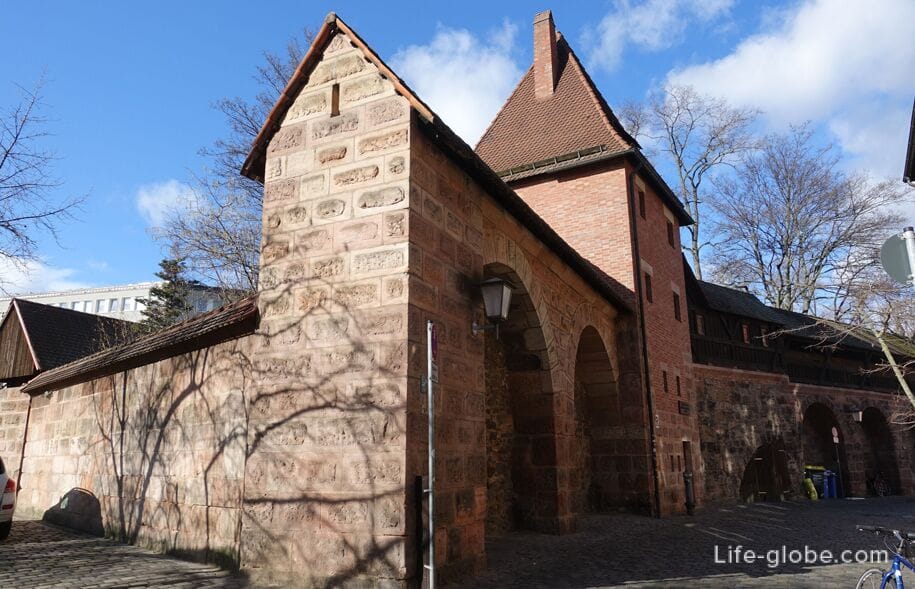
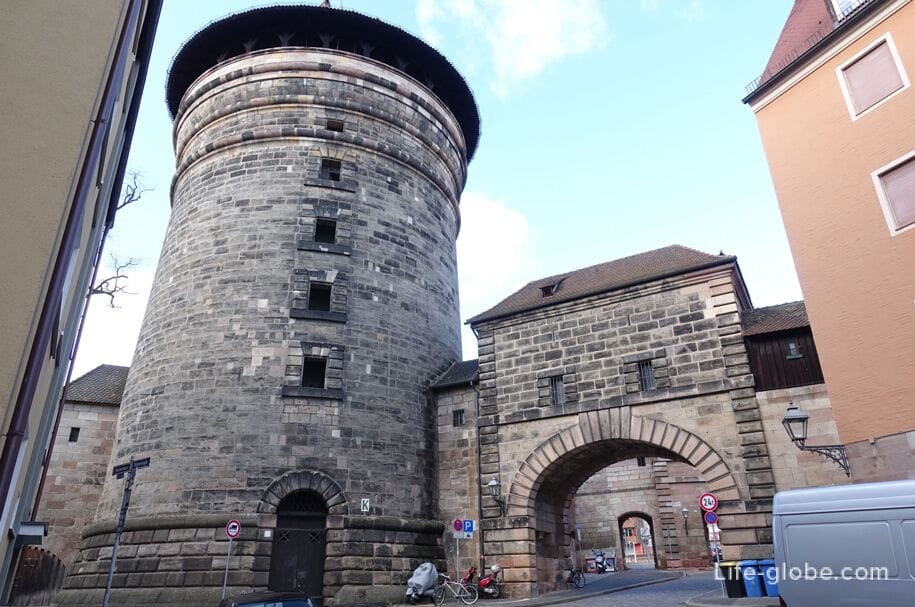
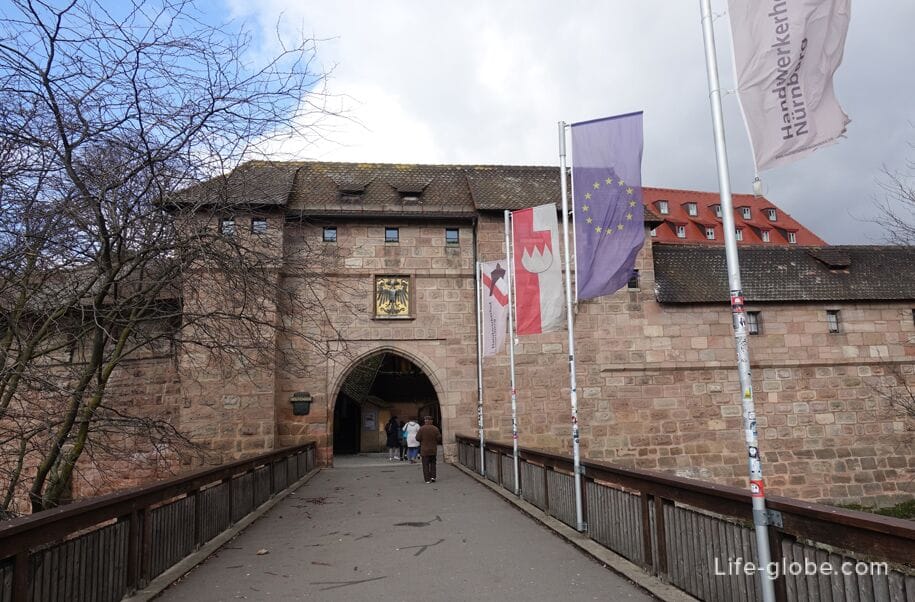
St. Martha's Church
The Church of St. Martha (St. Martha / Marthakirche) dates back to the 14th century.
The church has a Gothic style. There is an organ inside.
The hidden location of the church is noteworthy - in the gap between two houses.
Services and concerts are held in the church.
Church address: 79 Königstraße.
Website: stmartha.de .
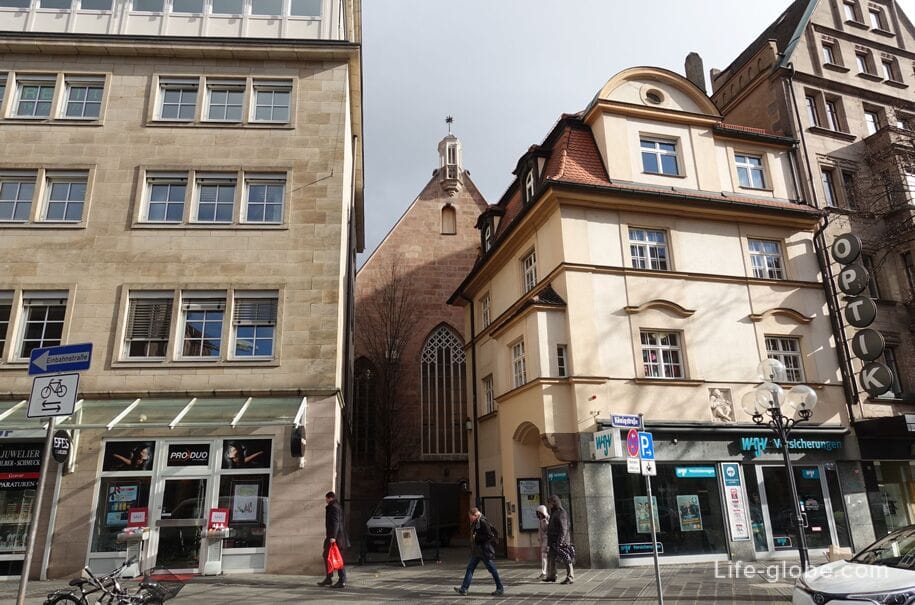
St. Clare's Church
The Church of St. Clara (Offene Kirche St. Klara / St. Claire) or Klarakirche is a Roman Catholic church, which is one of the oldest preserved sacred buildings in Nuremberg.
The construction of the Romanesque-style church building was started in 1270. The consecration took place in 1274.
Since 1996, St. Clare's Church has been an open church without a parish with a wide range of spiritual and cultural offerings and events.
Today, the architecture of St. Clare's Church appears to be predominantly a Gothic building with few Romanesque elements, for example, the arch of the main portal, the remains of the cornice, individual Romanesque arched windows.
Church address: 64 Königstraße.
Website: st-klara-nuernberg. More about St. Clare's Church...

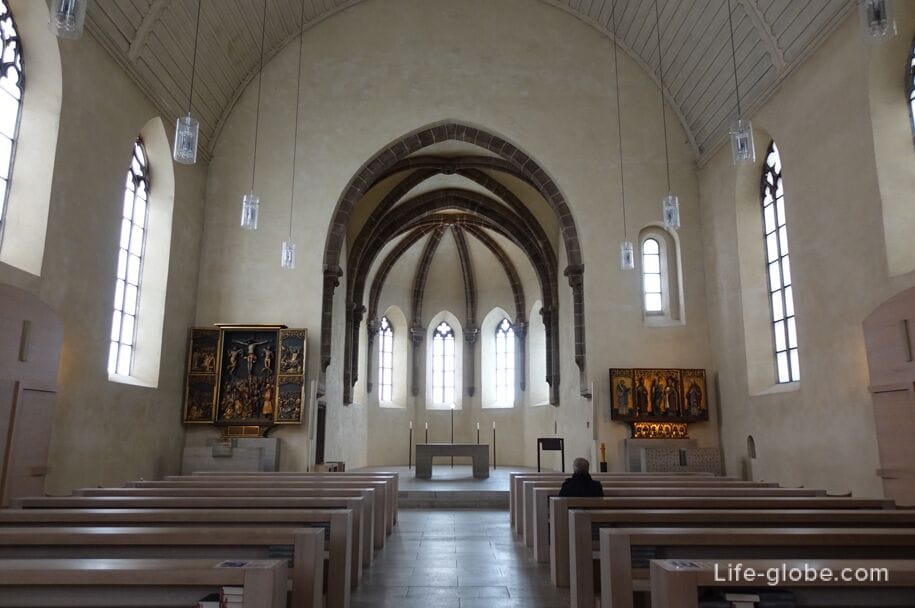
Customs Chamber
The Customs Chamber (Mauthalle, Mauthalle) is one of the most important buildings in "medieval Nuremberg".
The building was built in 1498-1502 by architect Hans Beheim the Elder. It was the largest granary in the city.
In 1571-1572, the imperial city customs and weighing office moved into the building, the basement of which served as a wine shop "Herrenkeller". The name "Mauthalle" was given to the building in the 19th century, when it was used as the main customs house.
In 1898, the building was converted into a commercial building. The basement has been used for gastronomic purposes since 1929, and for decades it housed a traditional Franconian restaurant, beer and wine bar.
After the building was damaged during the war, it was rebuilt in a simplified form from 1951 to 1953 and is now used as a commercial building.
The five-story gable roof of the building with two six-story cores is placed on a three-story sandstone building. The basement is a three-nave vault of the hall, supported by columns.
The eastern side of the building is decorated with a pointed arched portal with the image of the imperial eagle and the coat of arms of the city (the work of the sculptor Adam Kraft, 1502).
The building is located on the north side of An der Mauthalle Square.
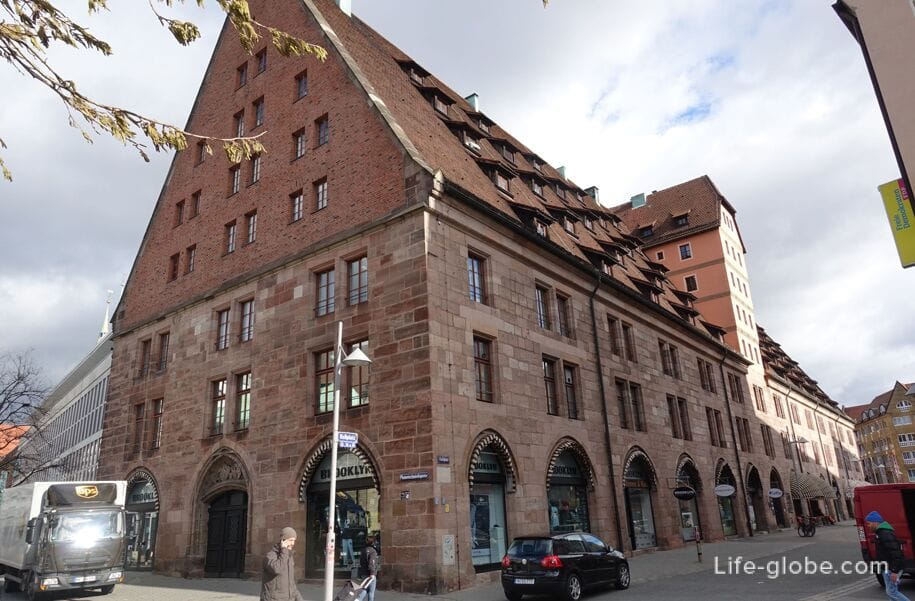
St. Lawrence Church
The Church of St. Lawrence or the Church of Lorenz (Kirche St. Lorenz), also known as the Lorenzkirche (Lorenzkirche) is one of the first churches in Germany to become Lutheran (since 1529).
The construction of the church took place in the period, presumably between 1243 and 1315, on the site of a former chapel in the Romanesque style. Subsequently, the church was expanded.
Today, the Gothic Lorenzkirche is one of the most outstanding buildings in Nuremberg.
The interior of the three-nave church impresses with its rigor and abundance of details. Powerful columns with arched ceilings complement the overall Gothic ensemble.
Church address: Lorenzer Platz, 1.
Website: lorenzkirche. More about the Lorenz Church...
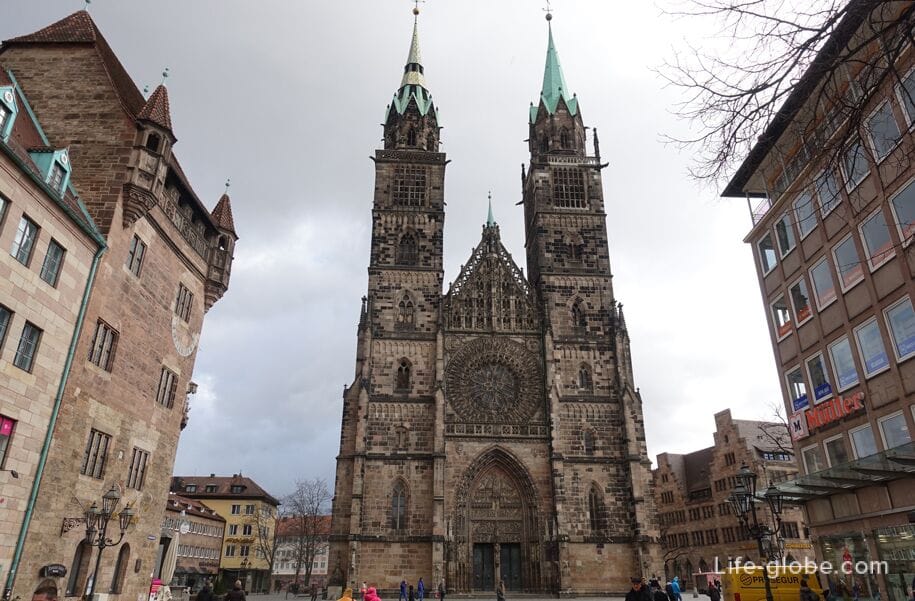

Nassau House
The Nassau House, also known as the Schlusselfelder Foundation House (Schlusselfeldersche Stiftungshaus) is a medieval residential tower, which is the only surviving residential tower in Nuremberg, and is considered one of the few examples of Romanesque architecture in the city.
The Nassau House has a corner location and is built in a row with other buildings. It is made of red sandstone on the model of northern Italian residential towers. It has four floors and a gallery, which is crowned by a high roof.
Address of the house of Nassau: Karolinenstraße, 2. More about the House of Nassau...
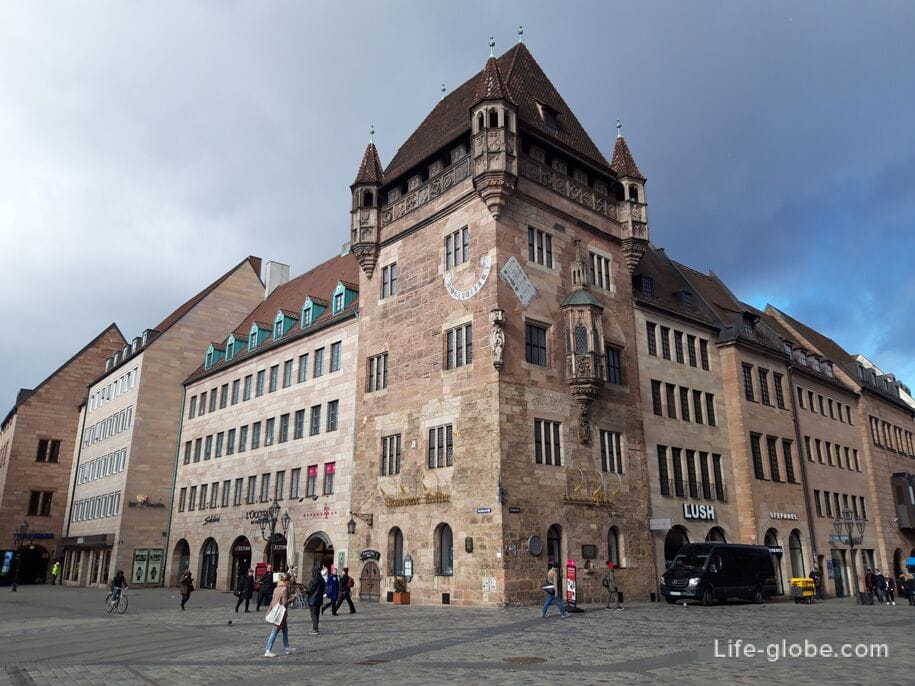
Holy Spirit Hospital
The Hospital of the Holy Spirit (Heilig-Geist-Spital / Heilig-Geist-Spital) is the oldest and once the largest medical institution in Germany.
The hospital was built in 1332-1339 together with the church. The infirmary, as in many medieval cities, was dedicated to the Holy Spirit.
Today, the complex of the Holy Spirit Hospital is a historical and architectural "pearl" of Nuremberg, is included in the list of the main attractions and most tourist routes around the city.
The walls of the hospital now house a nursing home and a restaurant "Heilig-Geist-Spital Nürnberg", with tables in the courtyard.
Due to the fact that the wing of the hospital is located above the waters of the river, and its arches are lowered into the water, locals also call the hospital "Nuremberg Glasses".
Also noteworthy is the restored picturesque bay window with a pointed tower.
The best and most photographed view of the Gothic wing of the hospital opens from Museum Bridge.
Hospital address: Spitalgasse, 16. More about the Hospital of the Holy Spirit...
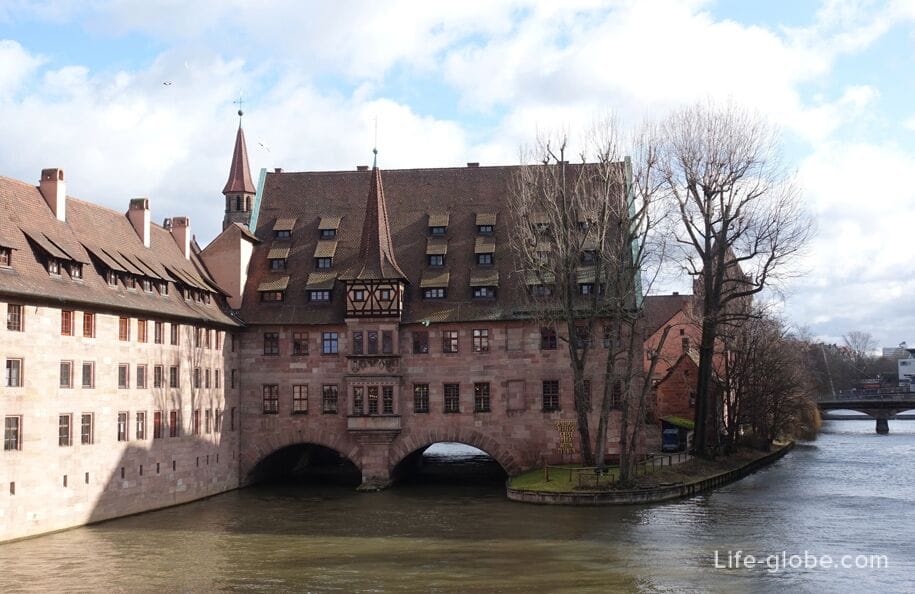
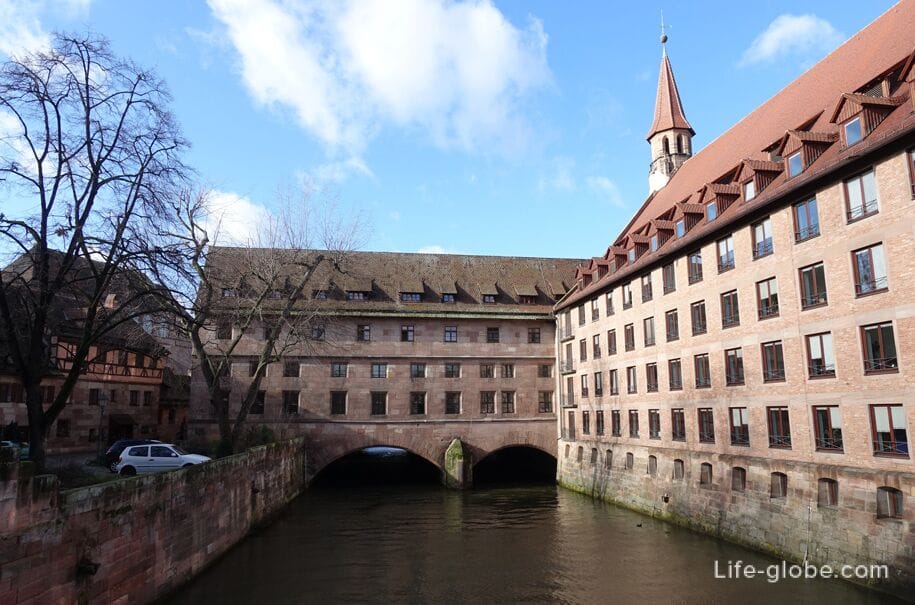
Synagogue Monument
The synagogue monument (Synagogendenkmal) perpetuates the main city synagogue on Hans-Sachs-Platz, which was opened in 1874, had a Moorish-Byzantine style and was considered one of the most beautiful in Europe.
On August 10, 1938, the synagogue was blown up by the Nazis because it "spoiled the beautiful German ensemble of the city."
Today, on the site of the synagogue there is a memorial consisting of a relief of a defunct synagogue, created by Reinhard Heiber (1988), and a memorial stele in front of it, created by August Hofmann (1970).
To the left of the synagogue memorial is a plaque commemorating the execution of German businessman of Jewish origin Leo Katzenberger.

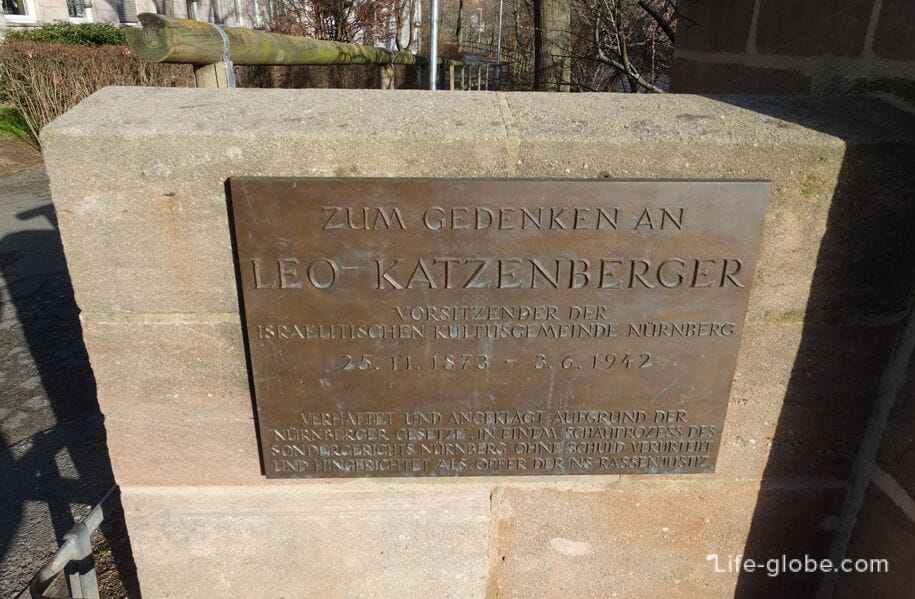
Debtors' Tower
The Debtors' Tower or Debt Tower (Schuldturm / Schuldturm), presumably, was part of the so-called penultimate city fortifications, and was built in 1323 under the supervision of master builder Konrat Stromer.
After its construction, the tower was located within the city, and it was turned into a prison for debtors, and also used as so-called stupid houses for the mentally ill.
The tower is located on the west side on the island of Schuette. More about the Debtors' Tower…
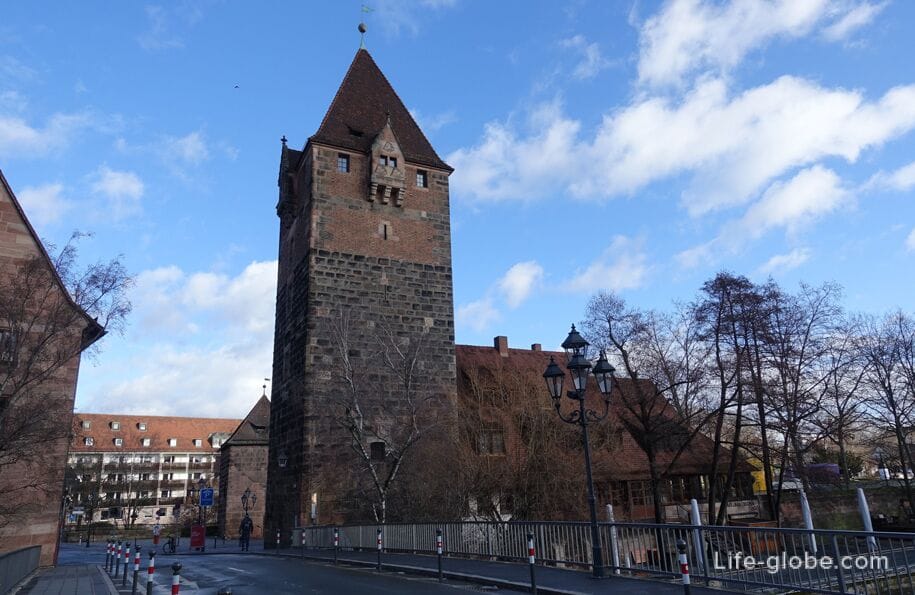
Ruins of the Katerinakirche
The ruins of the Church of St. Catherine (Katharinenkloster) are part of the ruins of the former convent of the Dominican Order in Nuremberg, famous for its medieval library.
The monastery was founded at the end of the 13th century. The monastery church was consecrated in 1297.
After the Reformation, the monastery lost its functions and was closed in 1596. Then it was used for various purposes.
In 1945, the monastery was destroyed and today the ruins of the former monastery church of St. Catherine, due to the special acoustics, are used for open-air concerts.
The address of the ruins of the church: Am Katharinenkloster, 6.
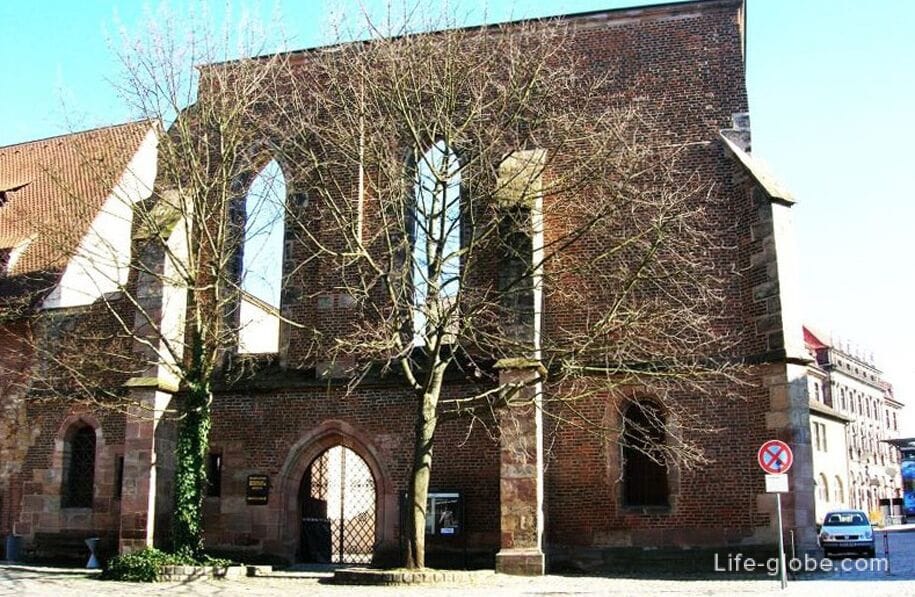
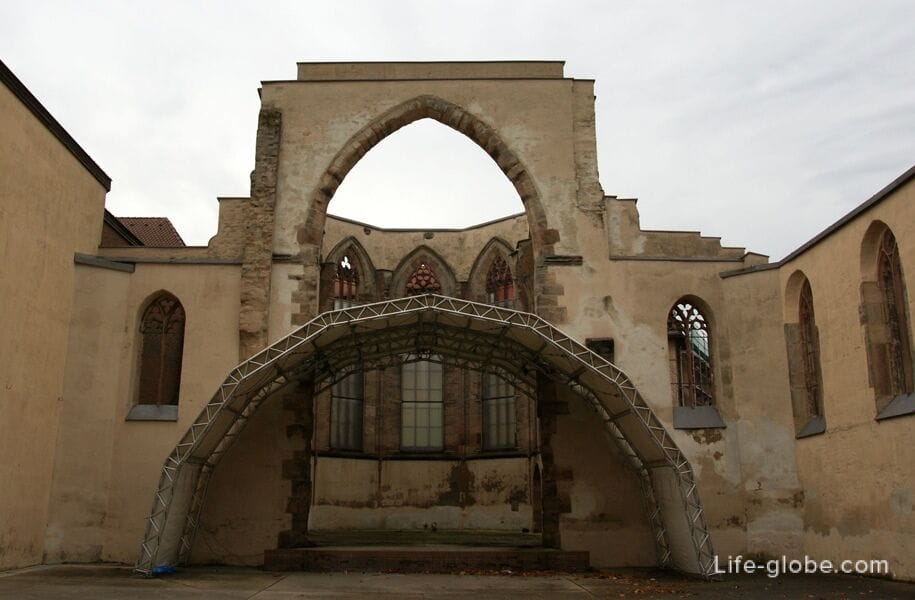
Market Square
The Market Square (Hauptmarkt) is the main square of Nuremberg, which is represented by four points in the route "Historical Mile of Nuremberg", these are: the Main Market itself (square), the Frauenkirche, a beautiful fountain, the City Hall and the Bull portal.
The market Square is almost entirely the pedestrian center of the city and a place where something is constantly happening - whether it's the weekly market or the main Christmas market of the city. And the square is surrounded by an ensemble of buildings, some of which are the main attractions of Nuremberg. More about the Market Square...
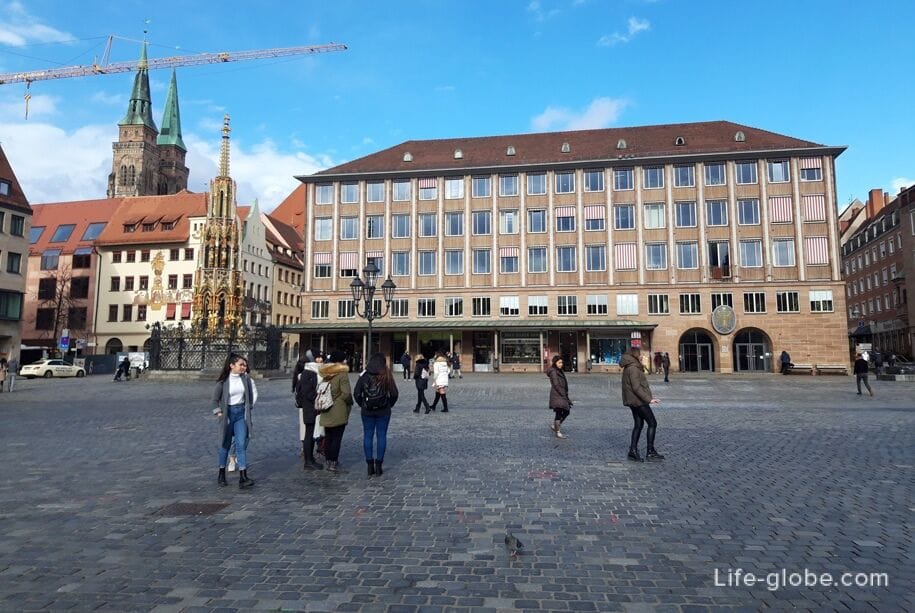
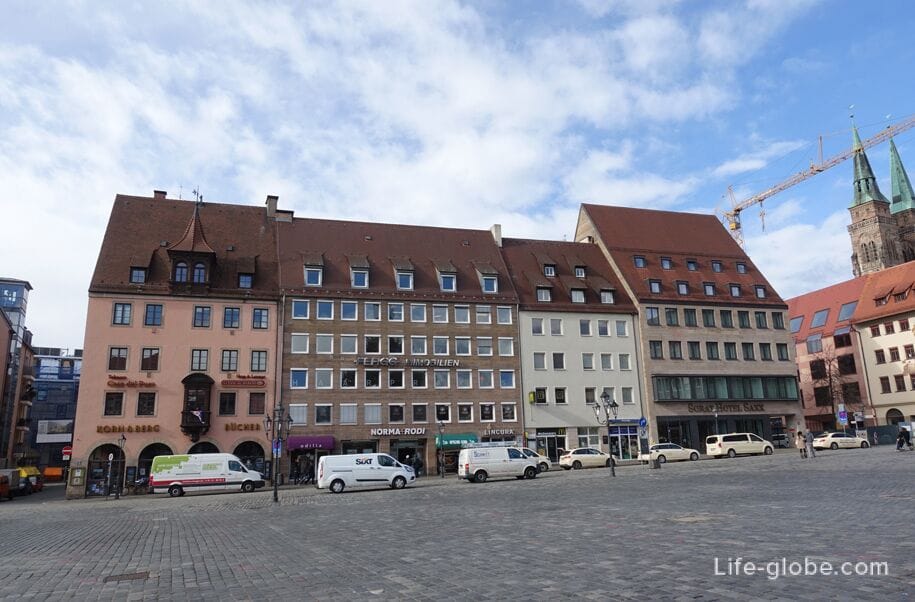
The beautiful Fountain or the Beautiful Fountain (Schöner Brunnen) is located on the northwestern edge of the square.
The fountain was built between 1385 and 1396 from sandstone. Today on the Market Square there is a colorfully painted copy of the shell-stone fountain (1903).
The beautiful fountain has a height of about 19 meters and the shape of a Gothic church spire. It consists of four tiers, which are decorated with gilding and 40 colorful figures (statues), personifying and representing scientists, evangelists and church fathers, electors and good heroes of different times, Moses and the prophets. Gargoyles in the lower part of the fountain symbolize the seven deadly sins, and are also designed to protect the city from dishonesty.
There is a rotating brass ring on the grating of the fountain. Legend has it that if you turn the "golden" ring of a Beautiful fountain once, then three wishes will come true, and if you turn it three times, you can expect many children. More about the Beautiful Fountain...
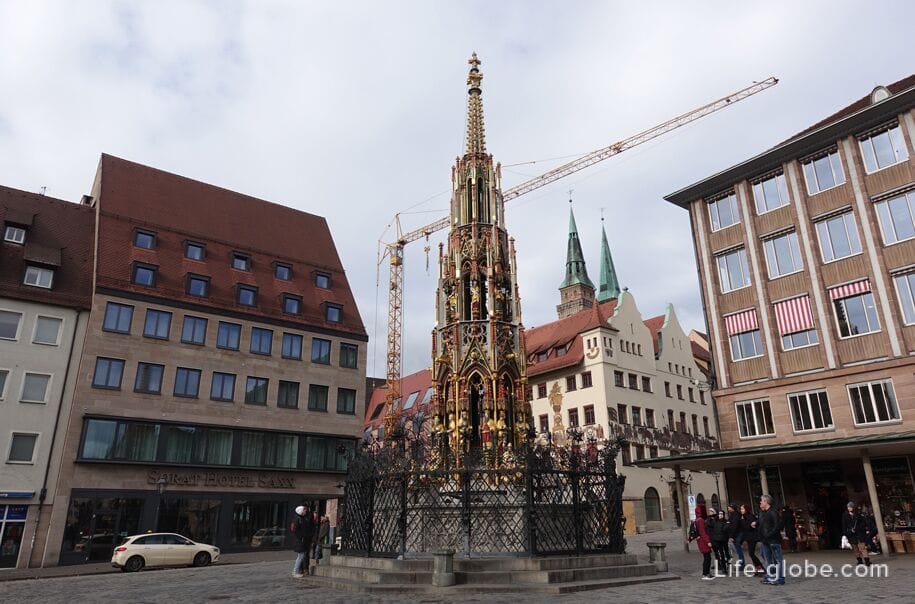
The Church of the Virgin Mary or Frauenkirche (Frauenkirche) is the main dominant of the square and is located on its eastern side.
The church was built as an imperial court chapel and a communal church building. The construction of the church was carried out from 1352 to 1362 on the initiative of Emperor Charles IV.
The powerful exterior Gothic appearance of the church immediately catches the eye.
In the upper part of the facade there is an art clock with moving figures. The Christmas market opens annually on the balcony with colorful figures. Every lunch break at 12 o'clock in the afternoon, the figures on the balcony "walk" - seven electors who have the right to elect emperors pay tribute to the Roman-German emperor Charles IV.
The interior of the Frauenkirche has three naves separated by tall columns.
The interior is dominated by the organ and the main altar, as well as numerous preserved works of art, including from the Middle Ages. More about the Frauenkirche...


On the northern edge of the square, the ensemble of Nuremberg Town Halls, consisting of the Old Town Hall and the New Town Hall, is notable.
The Old Town Hall (Altes Rathaus) is one of the most important buildings of the city, where offices and authorities have been located since the Middle Ages.
The construction of the Old Town Hall took place in several stages and also included reconstruction and expansion.
Today's architectural ensemble of the Old Town Hall consists of two parts: the oldest part of the Town Hall - Gothic, built since the 14th century (between 1332 and 1340), and later, made in the style of the Italian Renaissance - built in the 17th century.
In the basements of the Old Town Hall there is a museum of medieval dungeons (Mittelalterliche Lochgefängnisse), which consists of a historical dungeon prison, the cells of which have been used since the 14th century for interrogations and detention of prisoners before the execution of sentences.
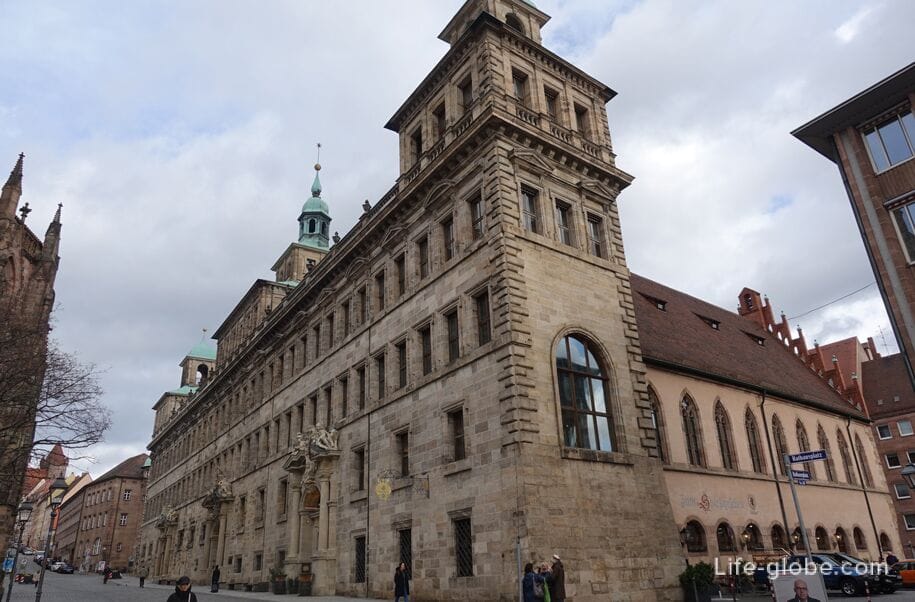
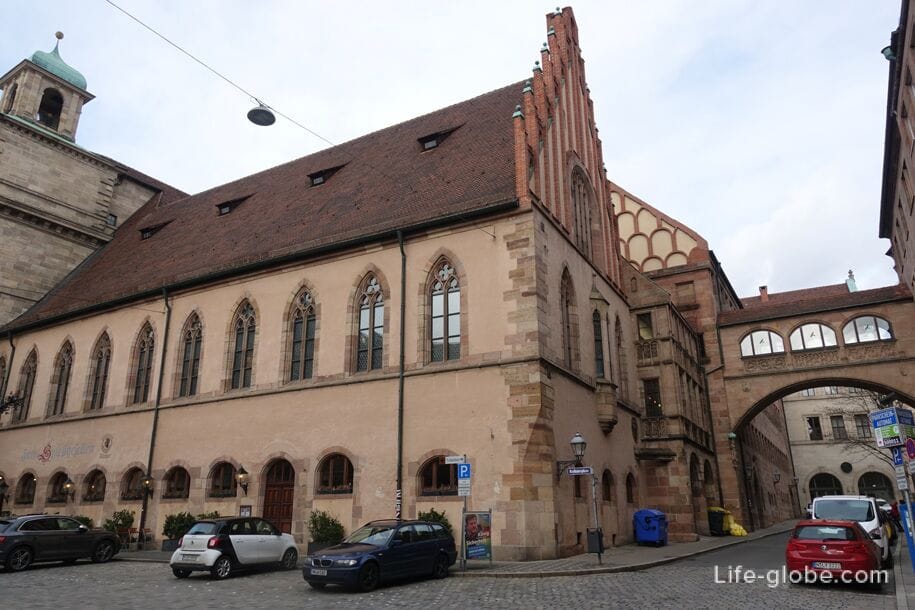
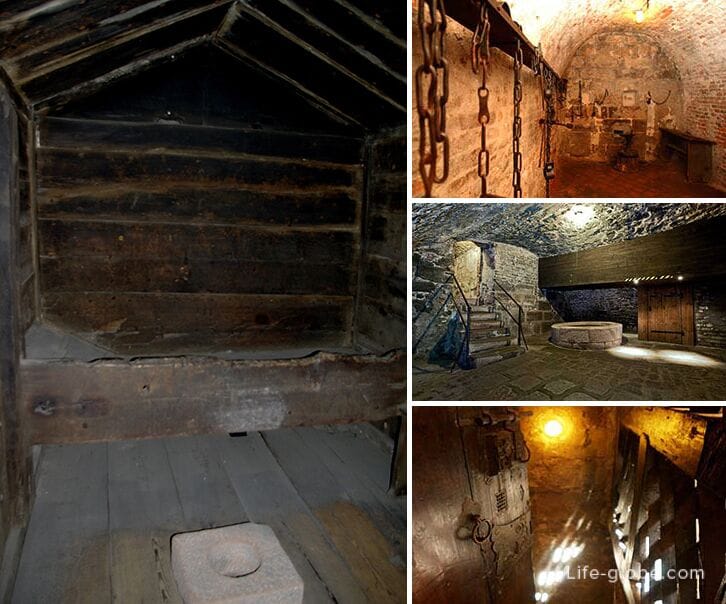
The New Town Hall (Neues Rathaus) is a detached building located on the south side of the Old Town Hall.
The main facade of the New Town Hall faces the north side of the Market Square.
The buildings between the then existing Town Hall (today the Old Town Hall) and the northern end of the main market were destroyed during World War II. In 1951, architect Kurt Schneckendorf designed a New Town Hall in their place, which is also known as Schneckendorf-Bau (Schneckendorf-Bau).
The construction of the town hall took place from 1954 to 1956.
The new Town Hall is architecturally in sharp contrast to the Old Town Hall and is made in the style of the 1950s with a lattice facade. More about the town halls and the museum...
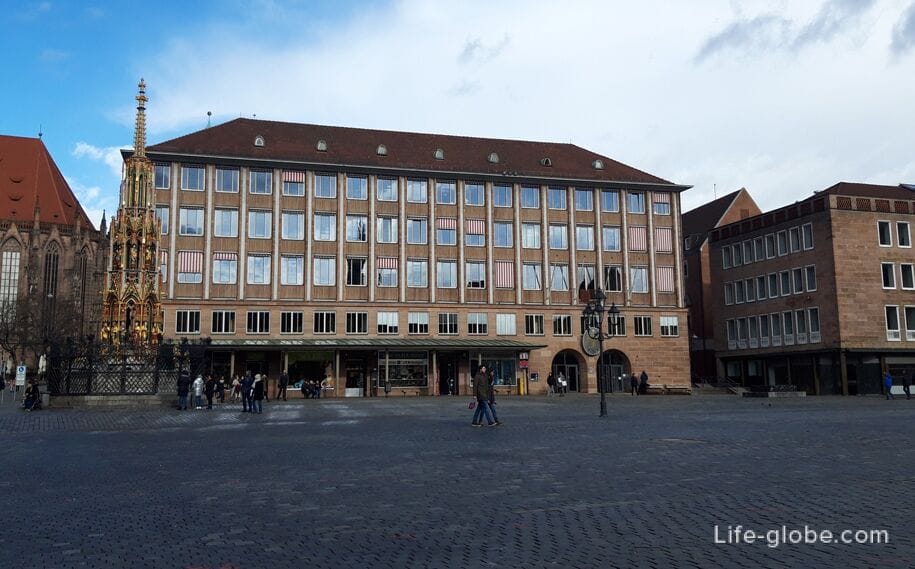
On the southern edge of the Market Square, at the north-western tip The Meat Bridge, there is a portal "Bull" (Das Ochsenportal, Bull Portal), which rests on one side on the former Meat House, and the other is adjacent to the Meat Bridge.
The portal is decorated with carvings and a stone figure of a reclining bull in the upper part. The portal was built in 1599 as the entrance gate to the Meat House building.
The portal was damaged during the Second World War. In 1950, the ox on the portal was replaced by a slightly modified copy.
The Latin inscription on the portal reads: "Omnia habent ortus suaque incrementa sed ecce quem cernis nunquam bos fuit hic vitulus", which translates roughly as: "All things have their origin (beginning) and growth, but look: the bull you see here has never been a calf."
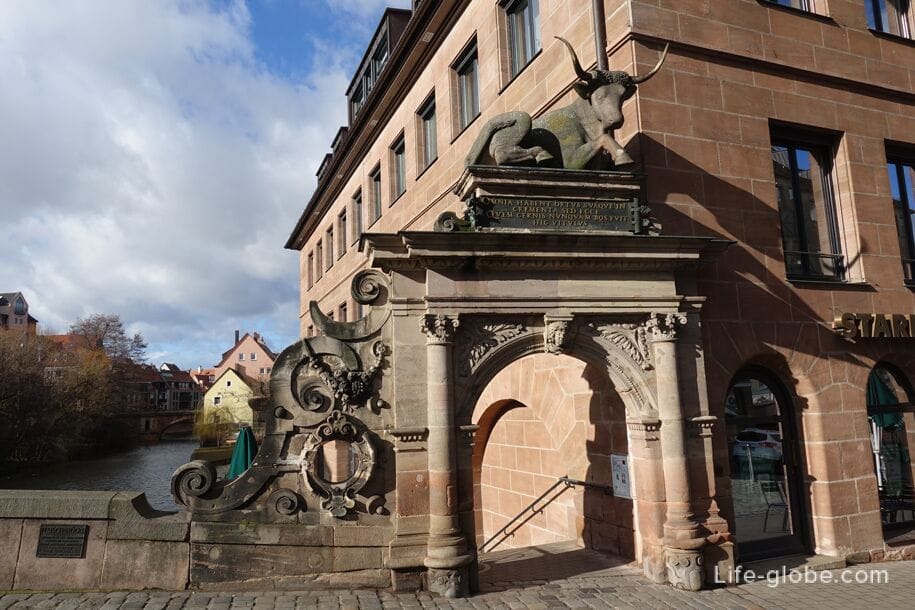
St. Sebald 's Church
The Church of St. Sebald (Kirche St. Sebald) or Sebaldkirche is the oldest parish church in Nuremberg and one of the most prominent church buildings in the city.
The construction of the Late Romanesque basilica with two choirs began in 1225-1230, on the foundation of the walls of the previous church, presumably dedicated to St. Peter.
By 1379, the side aisles of the church were expanded, the towers were raised in the high Gothic style and the altar of the late Gothic hall was built. Two towers were added in the 15th century.
Especially popular is the Schreyer-Landauer Epitaph (Schreyer-Landauer-Epitaph), located near the northeast end of the building.
The interior of the church has three naves separated by powerful columns with arched ceilings.
The interior reflects more than seven centuries of faith and the history of Nuremberg art.
Church address: Winklerstraße,26.
Website: sebalduskirche. More about St. Sebald's Church...

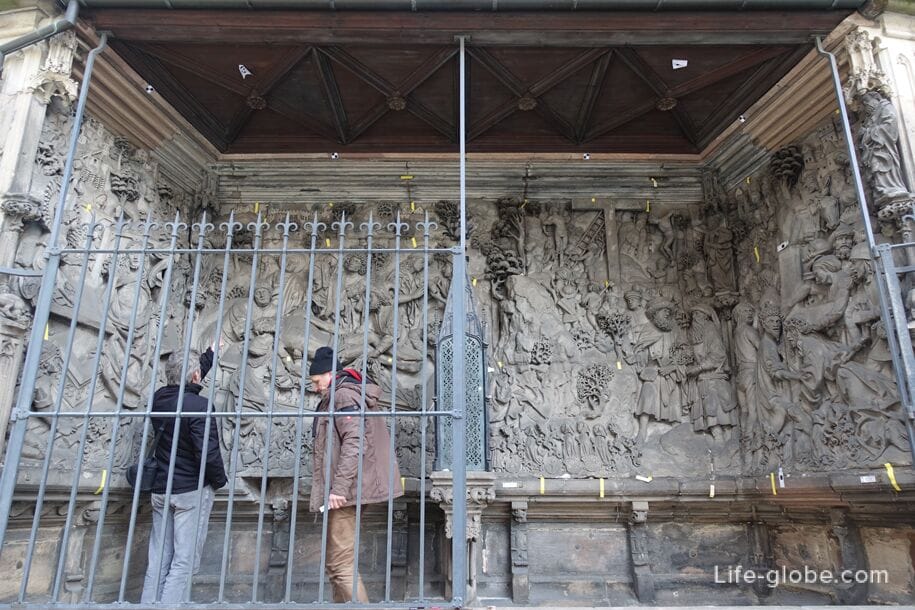
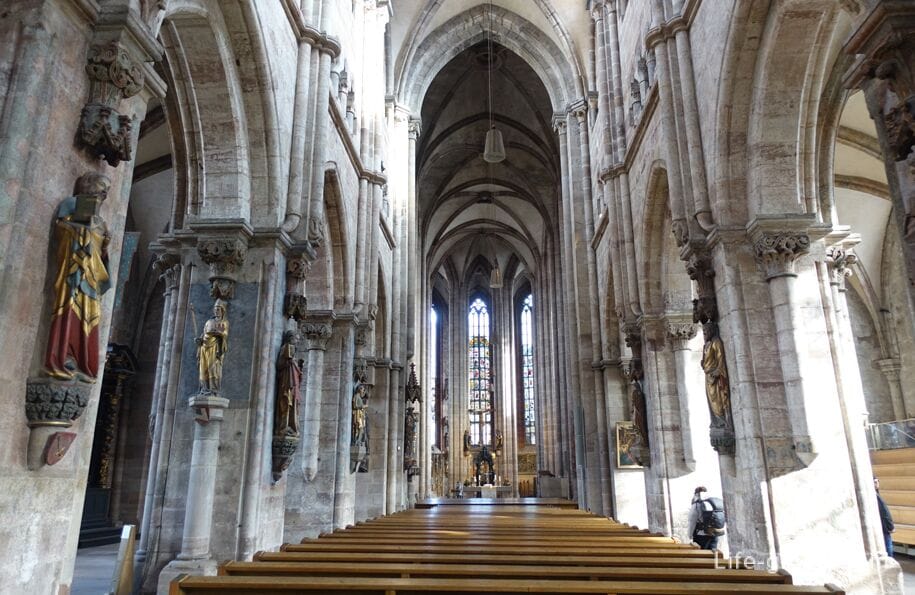
The parsonage of St. Sebald's Church
Next to the church of St. Sebald is the pastoral churchyard of the church (Sebalder Pfarrhof).
The house was built around 1361-1379, and once the clergy of the church lived in it: preachers, deacons and administrators.
The main decoration of the building is a Gothic bay window for the "Chörlein" home altar with scenes from the life of the Virgin Mary. Today it is a copy of 1898-1902, the Gothic original can be seen in The German National Museum.
The courtyard of the house is usually accessible.
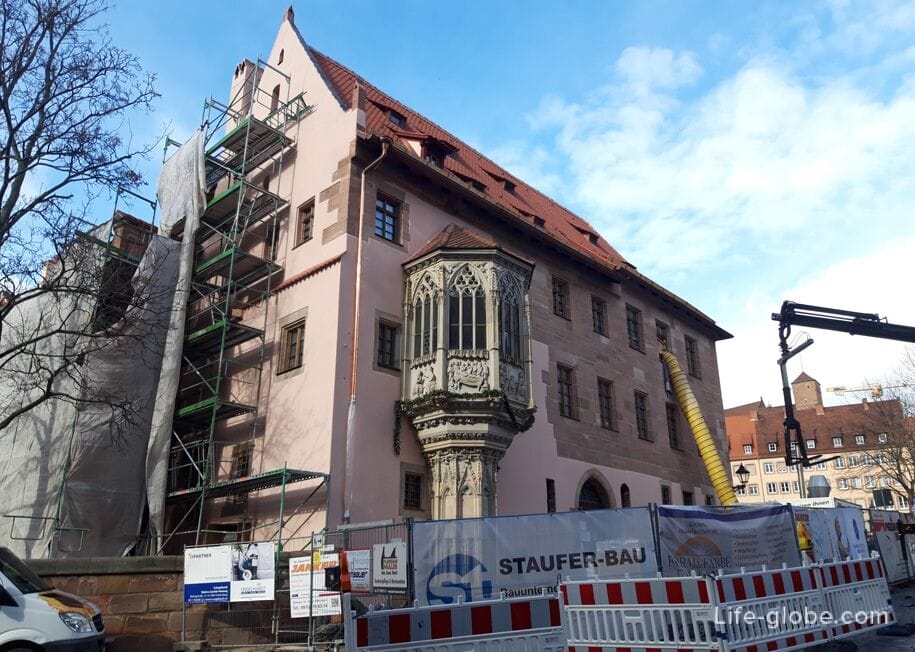
The Patrician House
Schürstabhaus is a former patrician house, which is considered one of the most important urban houses in northern Bavaria of the Gothic period.
The building was built around 1270 as two separate houses, which were later merged into one.
The house got its name from the Shurstab family, who owned the house from 1328 to 1478.
The architecture of the house is notable for sculptures, a small portal and a carved bay window in the Nuremberg style. On the southwest corner of the house there is a Gothic sculpture "Mary with the Baby" from 1482, the original of which is kept in the German National Museum.
Today, some rooms in this house can be rented for events.
House address: Albrecht-Dürer-Platz, 4.
Website: schuerstabhaus.
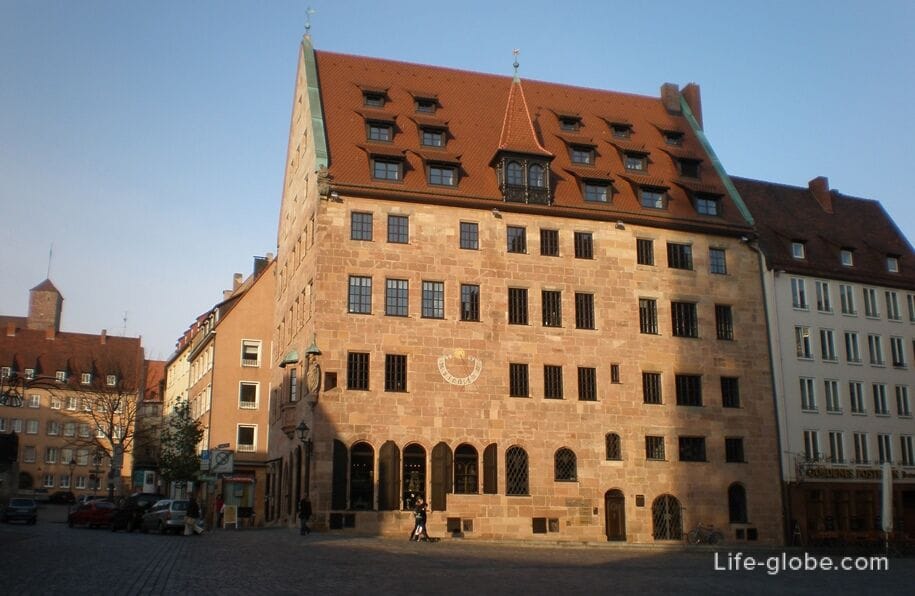
Fembo House - Nuremberg City Museum
The Fembo House (Fembo-Haus) is the only large merchant house of the Late Renaissance that has survived in Nuremberg, within the walls of which the Nuremberg City Museum (Stadtmuseum) is now located.
The house was built in the period from 1591 to 1596, presumably according to the plan of Jacob Wolf the Elder on behalf of the Dutch merchant Philip van Oerl, on the site of a previously existing building.
During its history, the house has changed several owners who have made their own changes to the interior of the building. The exterior of the house did not change.
House address: Burgstraße, 15.
Museum website: fembohaus. More about the Fembo House and the Nuremberg City Museum...
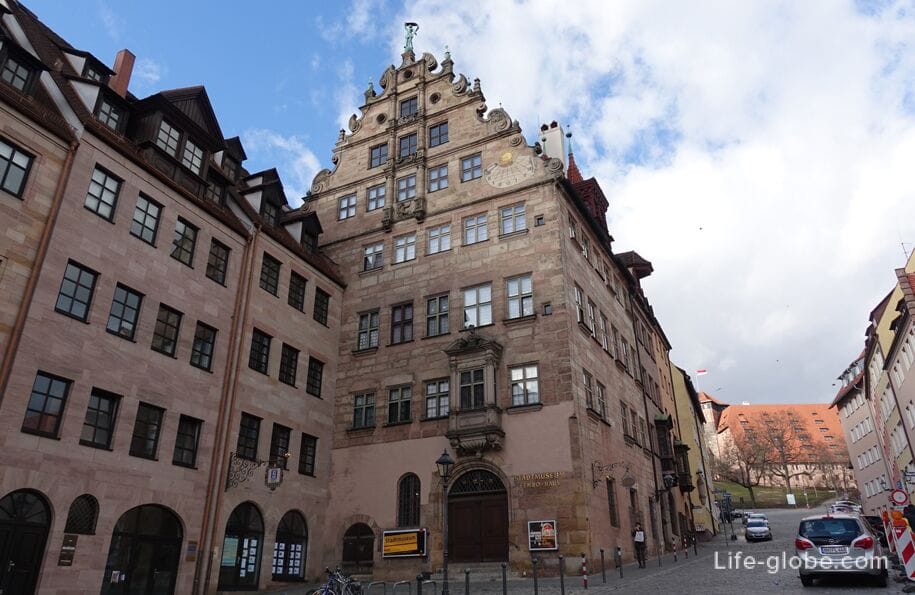
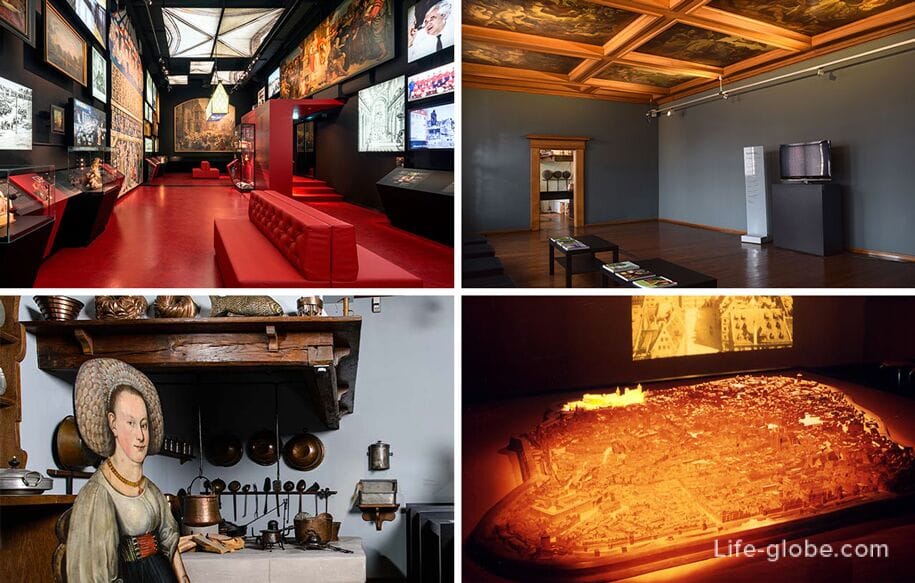
The Old Town Ensemble on the Kremergassen
Kremergassen (Krämergassen, Untere Krämersgasse) is the best preserved part of the modern old town with artisan houses and stone buildings.
The oldest house dates back to 1395.

Peller's House
The Peller House (Pellerhaus), also referred to as the "Mayersches Pellerhaus" in relation to the post-war building, is a building that has an attractively restored historic ground floor and part of the courtyard integrated into the new building.
The building in the style of Italian palaces was built for Martin Peller according to the plans of architect Jacob Wolf the Elder from 1602 to 1605 on the site of the former estate.
During the Second World War, the Pellerhaus was almost completely destroyed. Subsequently, only the arched walls up to and including the first floor and partially the courtyard of the former outstanding mansion were preserved and reconstructed. In 1957 they were integrated into a new building.
The address of the Peller house: Egidienplatz, 23. More about the Peller House...
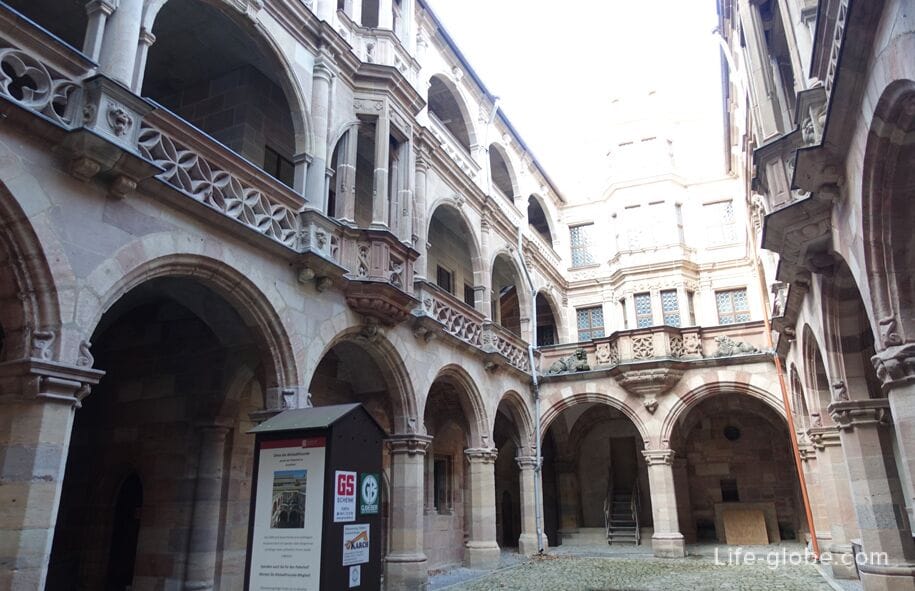
Tuher Castle
Tuher Castle or Tuher Castle (Tucherschloss) is the historical residence of the noble patrician family of Tuher.
The residence was built by Lorenz Tucher in 1533-1544, according to the designs, probably, of Paulus Boeheim, who designed the building based on the castles of the French Renaissance.
Today, a museum is located within the walls of the former residence. The public castle garden is adjacent to the museum.
The address of the castle of Tuchera: Hirschelgasse, 9-11.
Museum website: tucherschloss. More about the Tuher Castle and the museum...
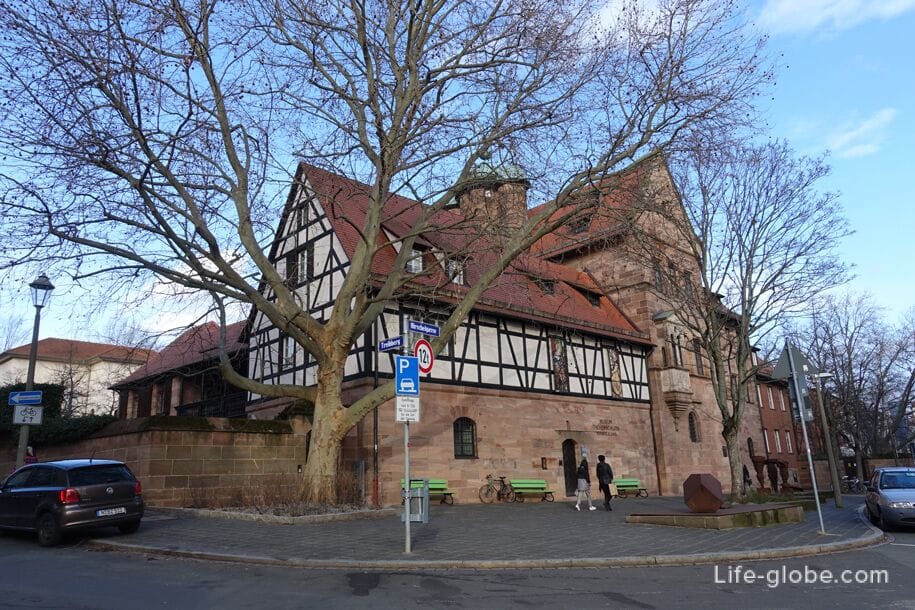

Seven Rows
Seven Rows or Seven Lines (Sieben Zeilen) is the name of the historical workers' village (quarter) in Nuremberg.
In the period from 1489 to 1524, houses were built in several rows on the filled-in moat of the former defensive fortifications of the city, as social housing for weavers from Swabia.
Today, the house that survived during the war in the former village of weavers, which was later rebuilt, is one of the important architectural monuments of the city.
Building address: Webersplatz / Sieben Zeilen. Learn more about the Seven Rows...

Nuremberg Fortress and Rock
Nuremberg Fortress (Nürnberger Burg), also known as Kaiserburg Castle (Kaiserburg Nürnberg) - the former residence of the rulers.
Today, the Nuremberg Fortress is a symbol and the main attraction of the city. It is a group of medieval fortified buildings and is considered one of the most formidable medieval fortifications in Europe, which personified the power and importance of the Holy Roman Empire, as well as the outstanding role of the imperial city of Nuremberg.
Museums are located in part of the fortress premises.
The fortress is located on the rock mountain "Nuorenberc", which is a separate location in the Historical Mile of Nuremberg, but visually the rock and the fortress are perceived as a single goal and are inseparable.
The address of the fortress: Auf der Burg, 17.
Fortress website: kaiserburg-nuernberg. More about the Nuremberg Fortress...
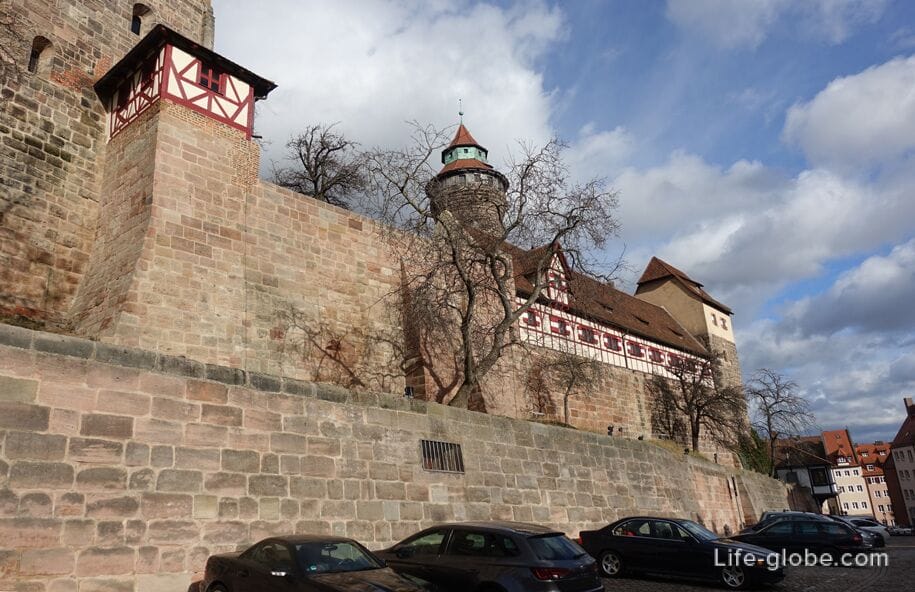
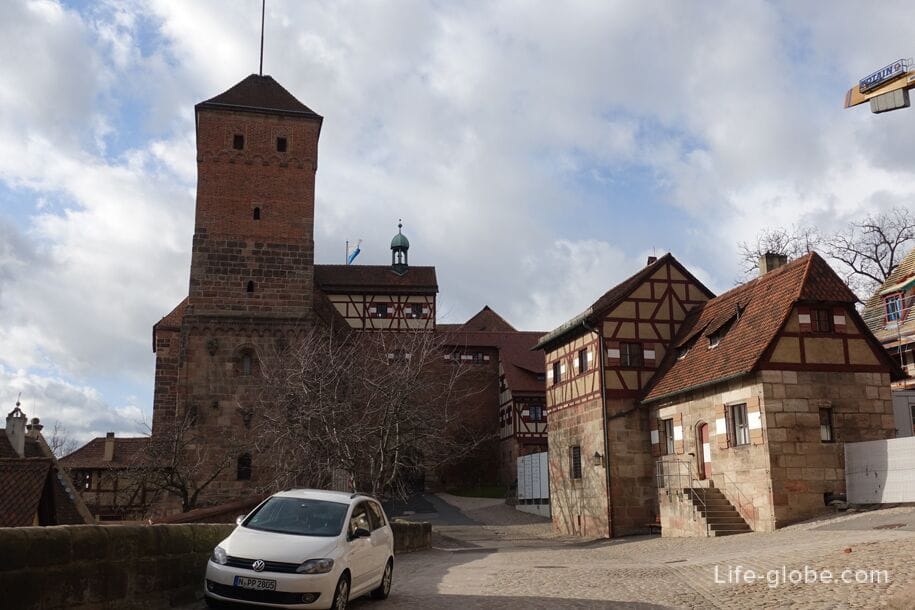
Artisans' houses
The preserved medieval houses of artisans (Handwerkerhäuschen) are located along the alley Am Ölberg, which runs at the foot of the rocky mountain with the Nuremberg Fortress.
Back in the 11th century, the first settlements for castle craftsmen, staff and merchants were founded south of the castle. This was the starting point for the development of the city of Nuremberg.
Artisans' houses were built as small one-storey residential and workshop premises, sometimes with one or two rooms. Later they were enlarged, but their medieval essence was preserved. The original thatched roofs were banned at an early stage due to the risk of fire. Only a few of these narrow two-storey houses survived the bombing during the Second World War.
This lane also houses the oldest wooden building in Nuremberg, dating back to 1338.
This place is one of the most important architectural monuments of the old city of Nuremberg, and very photographic.
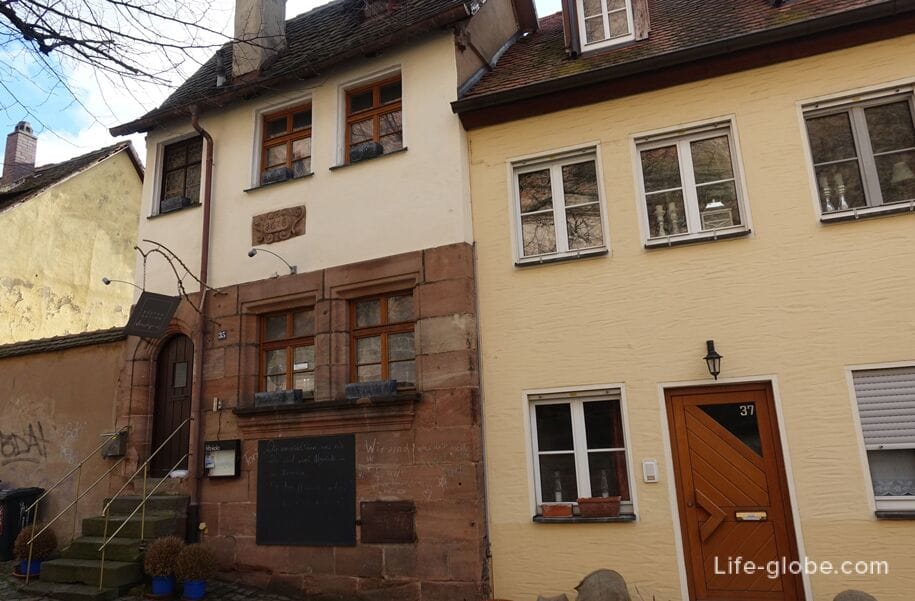

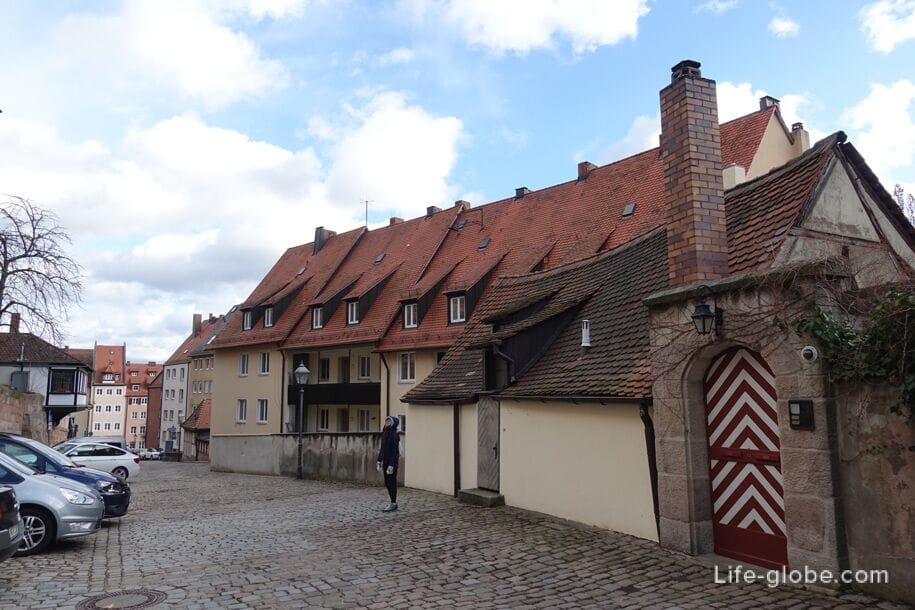
Tiergertnertorplatz Square
Tiergärtnertorplatz Square itself is not on the route of the Historical Mile of Nuremberg, but there are three locations that are located on the square and near each other.
Pilate's House (Pilatushaus) is a town house, which is one of the few surviving town houses in the late Gothic style and one of the most important architectural monuments of the old city of Nuremberg.
The house was built in 1489 and originally belonged to an armory blacksmith (Plattner) Hans Grunwald, who made knight's armor and equipment.
For this reason, the house was also called "the house of the man in armor". On the southeast corner of the building there is a statue of St. George, dressed in knight's armor and standing on a defeated dragon.
During the history of the building has often changed hands. Since 1931, the house belongs to the city of Nuremberg. Today the house is used for temporary exhibitions of contemporary art. More about Pilate's house...
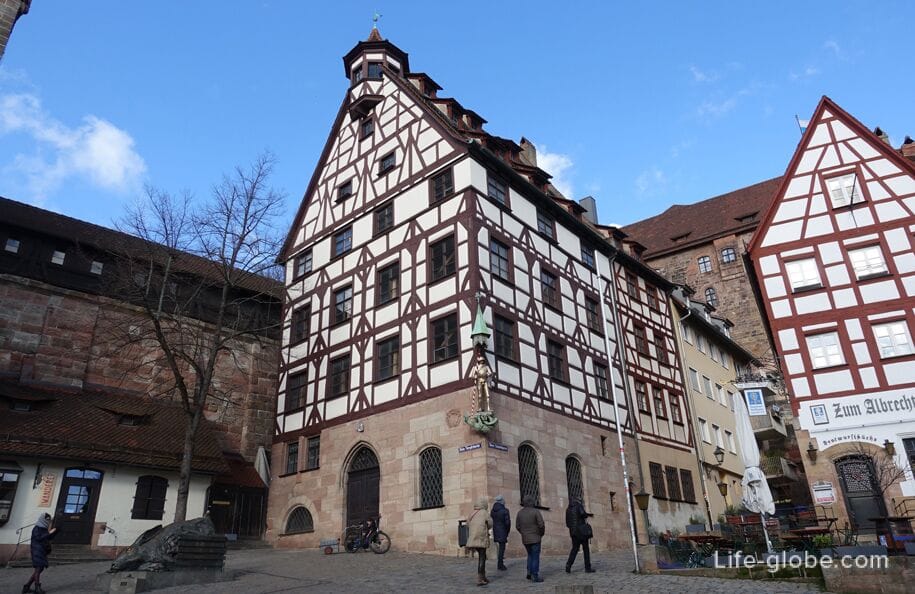
Albrecht Dürer House Museum (Albrecht-Dürer-Haus) is a preserved half-timbered house built around 1420.
From 1509 until his death in 1528, Albrecht Dürer (1471-1528), a German painter, engraver and graphic artist of the Renaissance period, lived and worked in the house.
In 1826, the city of Nuremberg acquired the house. Since 1871, the building has been a house museum dedicated to the life and work of Durer.
Museum website: duererhaus. More about the Dürer House Museum...

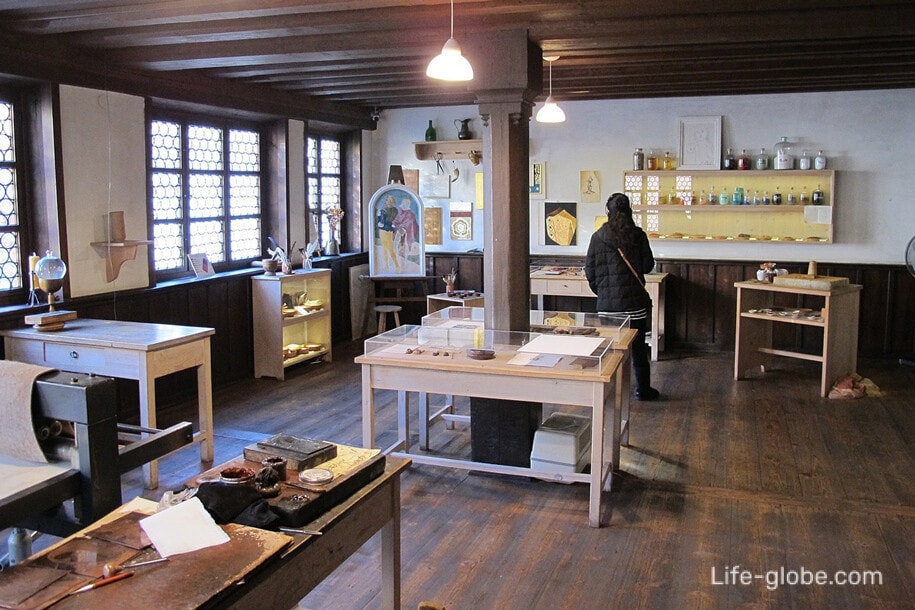
Gates Tiergartner (Tiergärtnertor) and Tiergartner Tower (Tiergärtnerturm), behind which is the Lower Bastion (Untere Bastei), on which the southern garden of the Imperial Palace (Südlicher Burggarten / Sudlicher Burggarten) is laid out.
The high pointed gate tower, which has a square base and a barbican, dates from the end of the 13th. The two upper floors with polygonal projecting corners were added in 1516. Learn more about Tiergertnertorplatz...
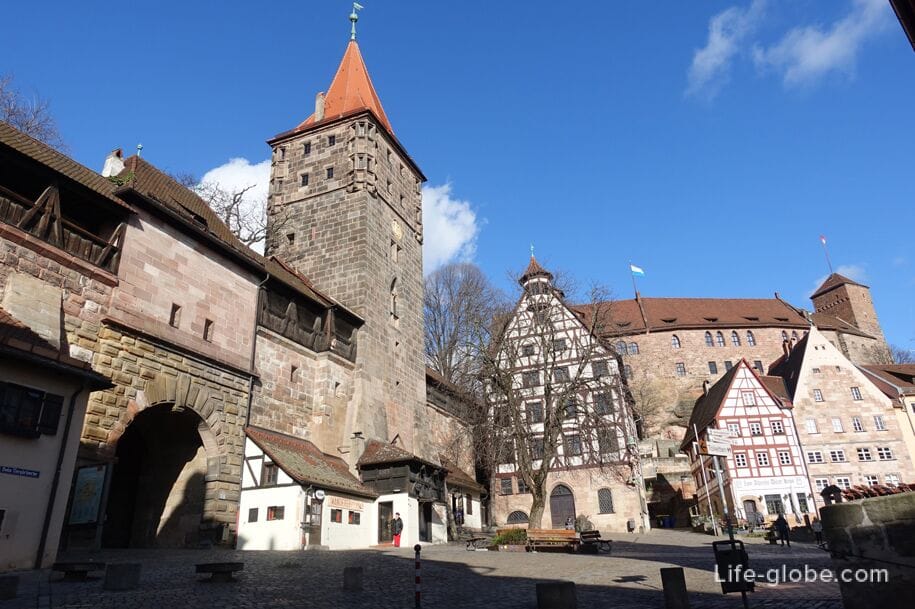
Museum "Bunker of Historical Art"
The entrance to the museum "Bunker of Historical Art" (Historischer Kunstbunker / historical Kuntsbunker) is through an unremarkable building. However, the museum itself is located in a rock under the Nuremberg Castle - a former beer cellar, in which, at a depth of up to 24 meters, during the Second World War, Allied troops discovered a Nazi bunker-cache with art objects and valuables taken from the occupied territories.
The museum offers guided tours of the Nuremberg dungeons.
Museum address: Obere Schmiedgasse, 52.
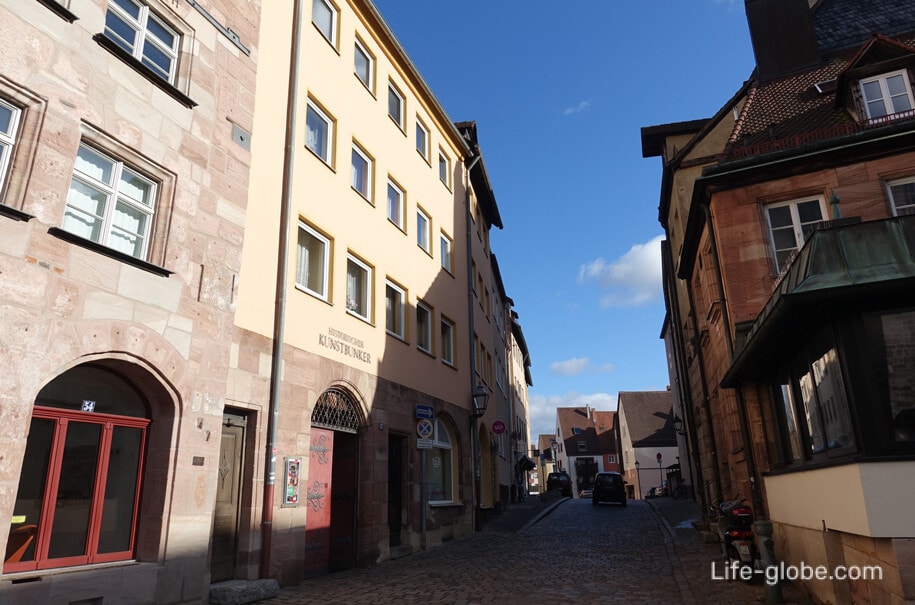
Rock crossings Nuremberg a
In addition to the bunker of historical art, other excursions to the dungeons (casemates) are held in Nuremberg.
In the Middle Ages, passages and rooms were laid under the Nuremberg fortress, bastions and defensive city wall (since 1545) - the so-called casemates (Kasematten) and rock passages (Felsengänge).
During the history of the casemates were used for various purposes: as hidden passages, emergency exits, a secret system of water pipes, beer cellars (warehouses for beer) and even as a prison.
Today there are guided tours of the casemates.
Website: felsengaenge-nuernberg. The site contains information, including about excursions to the historical bunker.
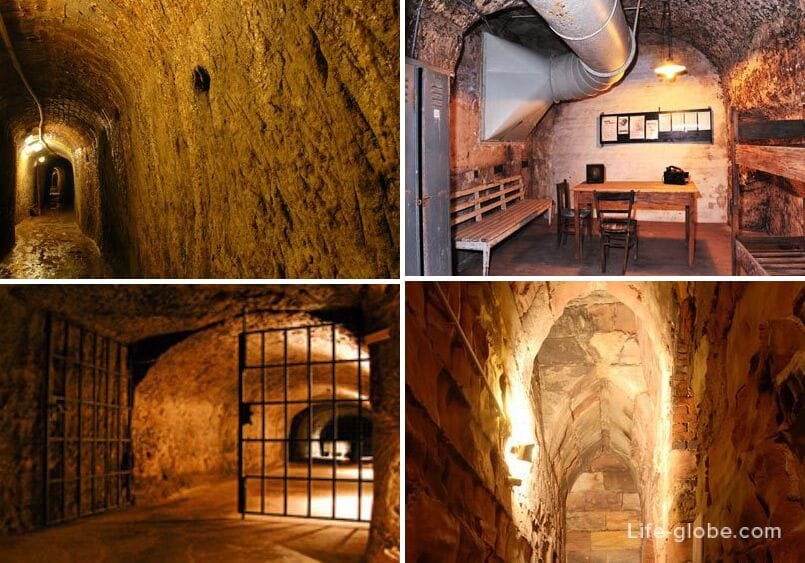
Weissgerbergasse Street
Weißgerbergasse is one of the most beautiful streets in Nuremberg, along which there are historical buildings, including half-timbered houses.
The name of the street comes from white tanners (Weißgerbern) who lived and worked in houses on the street in the Middle Ages.
More than twenty medieval artisan houses survived during the Second World War. Subsequently, they were carefully restored.
Thus, today Weissgerbergasse Street reflects a part of historical Nuremberg. And the buildings along the street are the largest architectural ensemble of medieval, and mainly half-timbered houses in Nuremberg. More about Weissgerbergasse street...
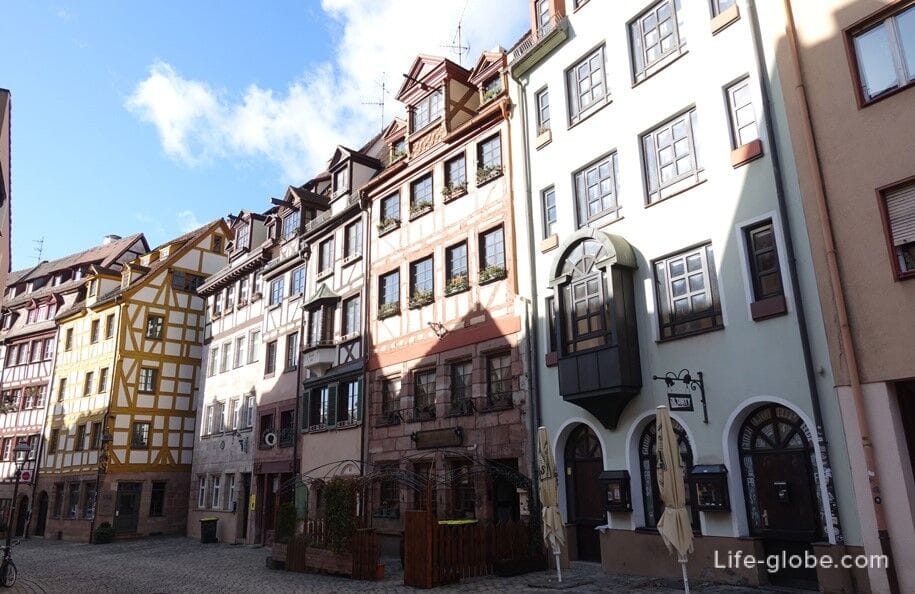
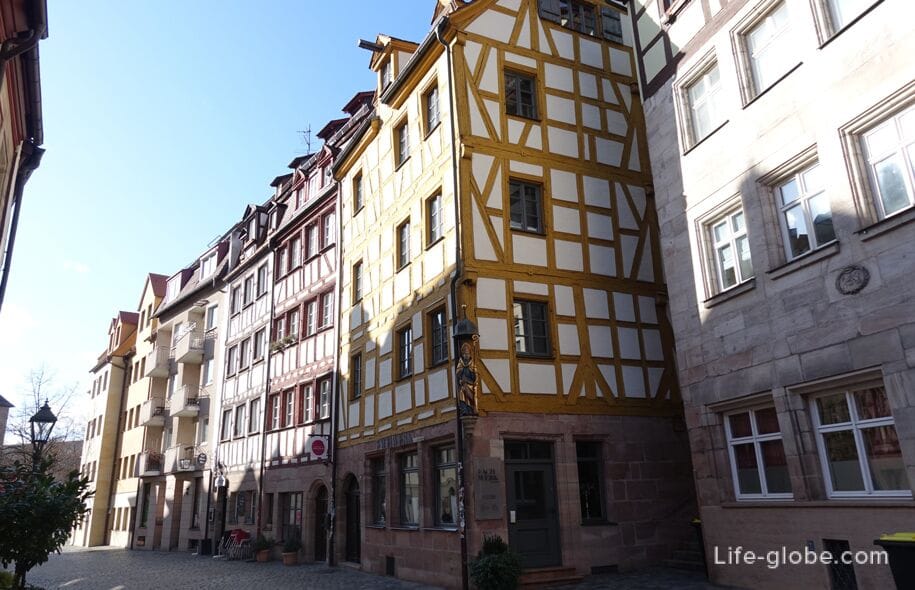
Hallershes House - Toy Museum
The Hallersches Haus was built in 1517 as an estate for the noble Nuremberg Haller family.
The exterior of the house is notable for the bay window, which was erected around 1720. The stepped pediment with scrolls and turrets is made in the German Renaissance traditions.
Today, the Nuremberg Toy Museum (Spielzeugmuseum) is located in the historic building, which is one of the most famous museums of its kind in the world.
The museum's collection displays the cultural history of toys from ancient times to the present day and contains about 87,000 exhibits, of which only a part can be seen on the museum's exhibition areas.
House address: Karlstraße, 13-15.
Toy Museum website: toy-museum. More about the toy house and museum...

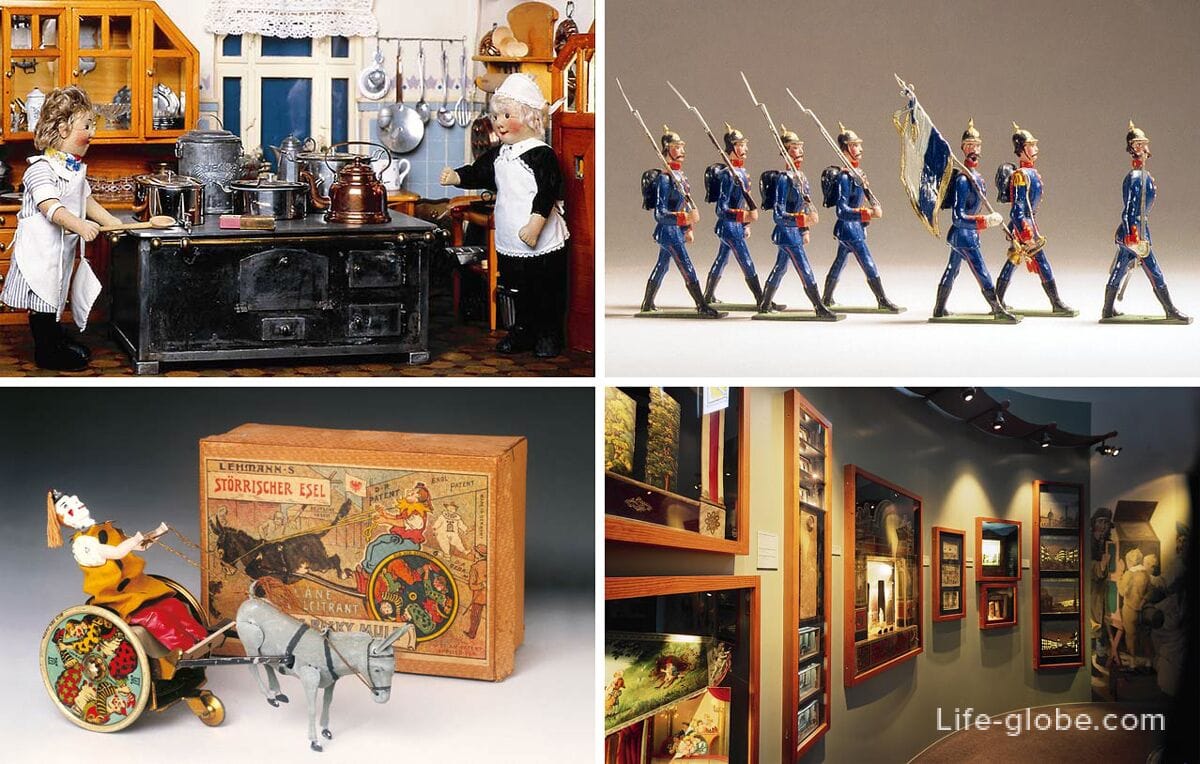
Chain Bridge
The Chain Bridge (Kettensteg) over the Pegnitz River, also called the suspension Bridge, is a narrow 68-meter pedestrian bridge, which is the oldest surviving iron suspension bridge in continental Europe.
The chain bridge was designed and built by engineer Konrad Georg Kuppler. The bridge was opened on December 30, 1824 and replaced a wooden walkway. During the history of the bridge has been subjected to repeated restoration and repair work.
The bridge has two spans, an iron main structure and a wooden base for movement. The bridge is located at the western edge of the old town, near the city walls and fortifications. Learn more about the Chain Bridge and city fortifications...
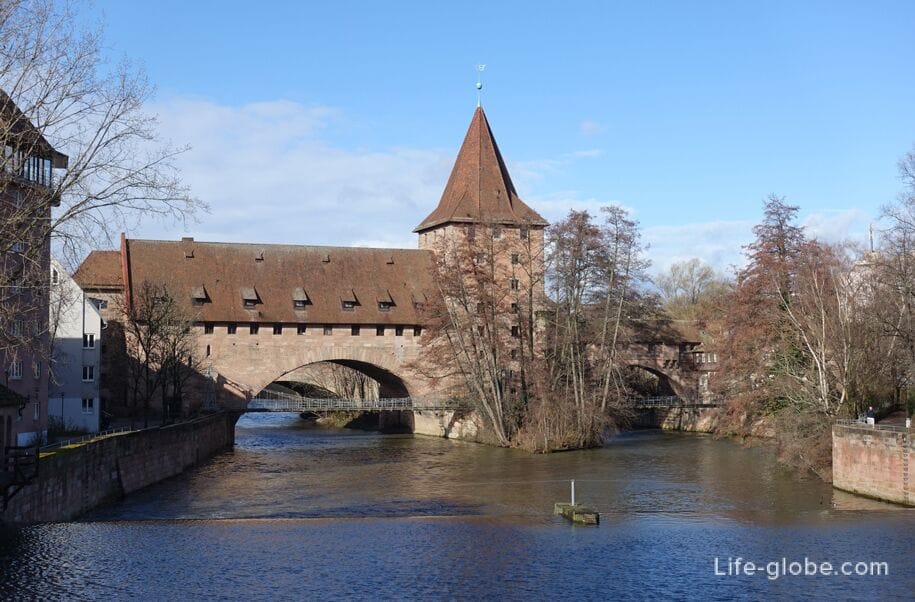
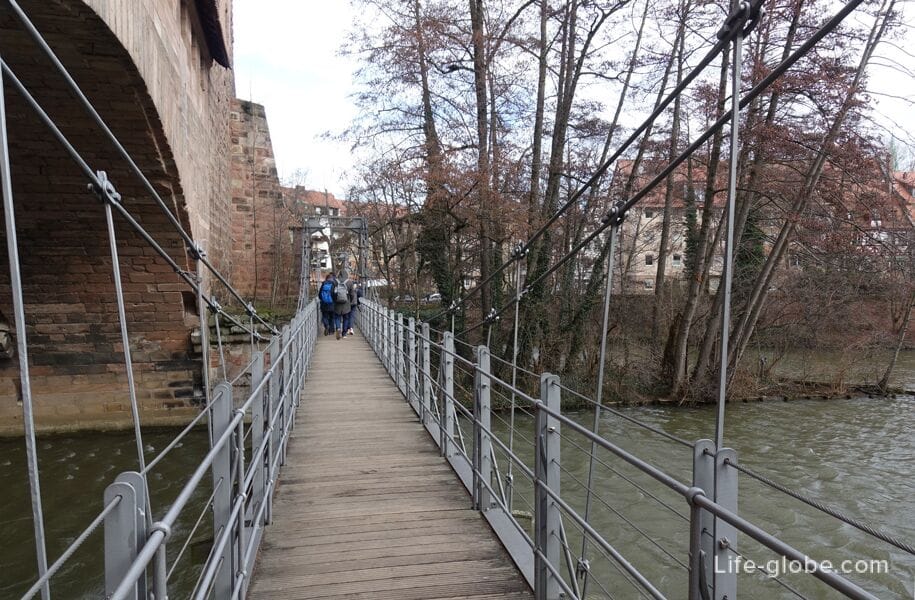
Fat Area and Fat House
Fat Square (Unschlittplatz) with an ensemble of medieval buildings is one of the important historical attractions of the center of Nuremberg.
After the Second World War (in 1972), several medieval houses on the square that survived the war had to be demolished, but the resistance of the activists of the city prevented the demolition. The houses were restored in the period from 1976 to 1981, and since then their ensemble resembles the former appearance of the square. Learn more about the Fat area...
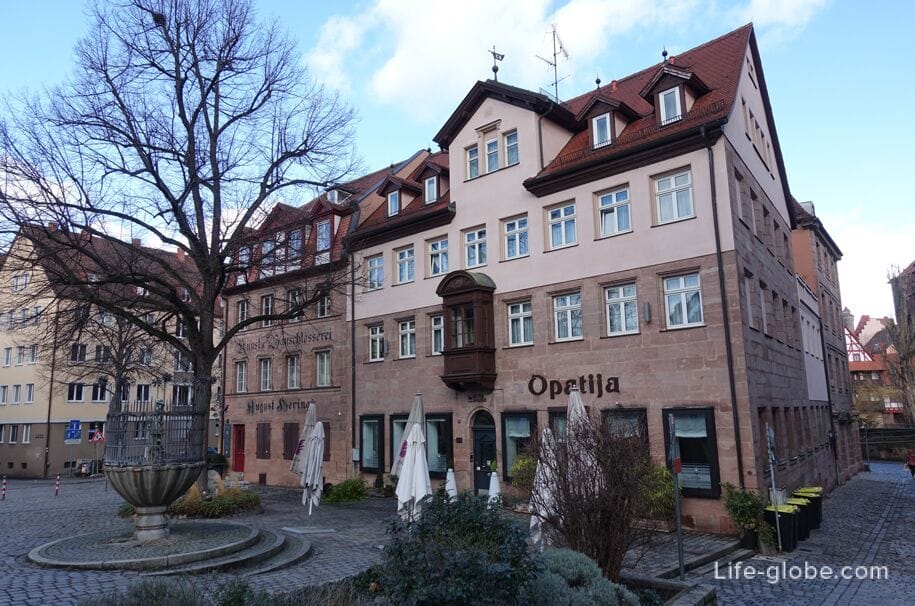
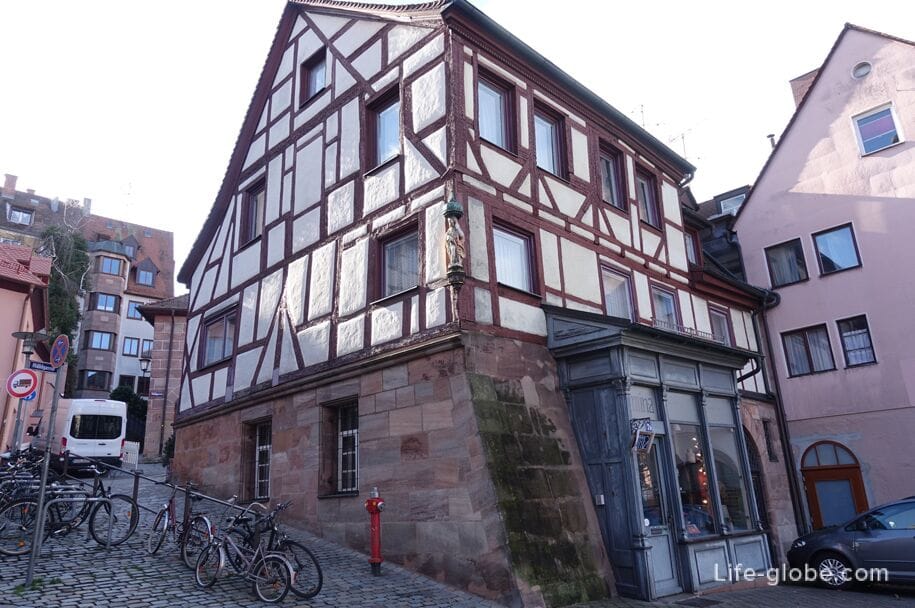
The name of the square "Unschlittplatz", which means "Fat Square" or "Greasy Square", comes from one of the historical buildings located around the square - Fat House or Greasy House (Unschlitthaus).
The building was erected by Hans Beheim the Elder in 1490-1491 as one of the granaries of the city.
Between 1562 and 1835, the building housed the city monopoly authority for the sale of fat (lard). Up until the 19th century, lard was of great importance as a raw material for the manufacture of tallow candles, soap, automobile grease and shoe wax.
Today, the historic building impresses with its massive structure, carefully thought out and perfectly fitting into the overall architecture of the building with a Gothic portal on the south side, an openwork Gothic stepped pediment and an overhanging roof.
The Fat House is located on the eastern edge of the Fat Square, at the address: Obere Wörthstraße, 26. More about the Fat House...
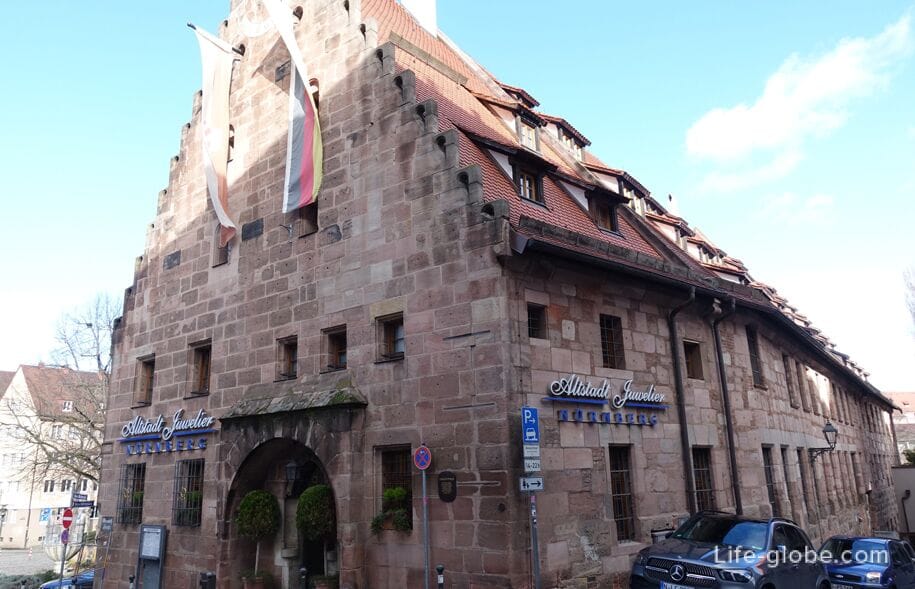
Wine Warehouse and Hangman's Bridge
The wine warehouse (Weinstadel) and the Hangman's Bridge (Henkersteg) are two points on the route "Historical Mile of Nuremberg", which are located near each other and which, together with the surrounding ensemble, are very difficult to consider separately, because this ensemble of attractions is one, if not the most picturesque and photographed in the center of Nuremberg.
Thus, the architectural ensemble is created by six historical structures: a half-timbered building of a former wine warehouse (Weinstadel), a square water tower (Wasserturm), a two-arch connecting bridge (Pegnitz Bridge / Pegnitzüberbrückung), a rounded wall tower of the Executioner (Henkerturm), a small hangman's house (Executioner house) and a pedestrian covered bridge of the Executioner (Henkersteg). More about the ensemble...
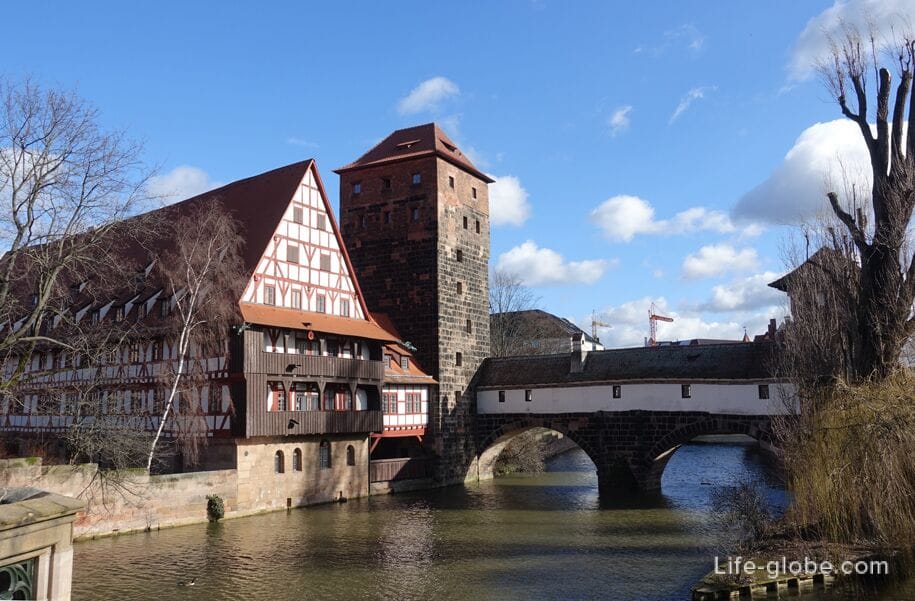

Hesperides Gardens
The Hesperid Gardens (Hesperidengärten) were originally part of the green belt of gardens along the city walls. Such gardens were popular with aristocrats in the 16th and 18th centuries. Citrus fruits, vegetables and herbs were grown in the gardens.
Small ornamental gardens were built around the summer residences of the rich in both Renaissance and Baroque styles, and equipped with a large number of fountains and sandstone figures. Valuable and exotic collections of lime and bitter oranges were grown in luxuriously decorated gardens, lawns and flower beds were also arranged in the gardens.
The Hesperides Gardens are located to the west of the old town (outside the city walls) and has only a few preserved plots and relics of the former magnificent setting. The narrow and rectangular gardens are orthogonal and oriented from north to south. And the former dachas of patricians and merchants form the structural border of small territories.
Thus, the three combined gardens at the back of the houses on Johannisstrasse 43-47 and the garden behind the house on Johannisstrasse 13 are open to the public.
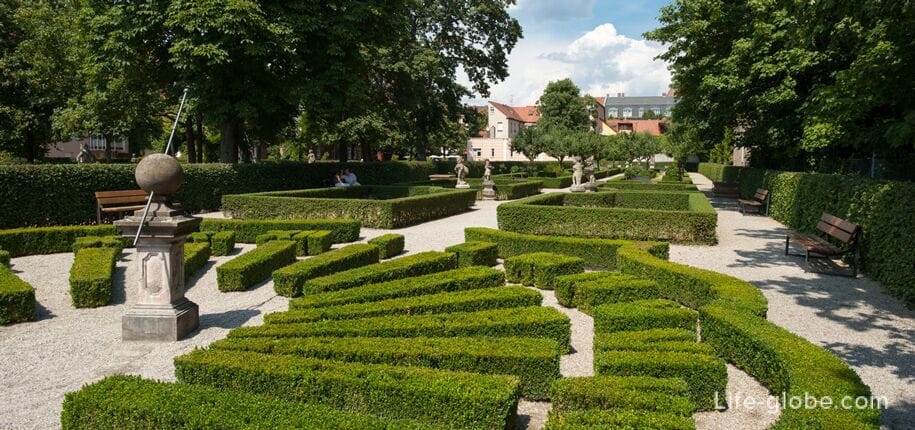
Cemetery of St. John and St. Rochus
The cemetery of St. John and St. Rochus (Johannisfriedhof, Johannisfriedhof) is a medieval cemetery outside the city walls, which is officially considered the most beautiful cemetery in Germany.
The cemetery is known for elaborate epitaphs and some tombstones. Among other celebrities, Albrecht Durer is buried in the cemetery.
In the cemetery is the chapel of St. Rochus (Church of St. John). The choir was opened in 1377, and the nave in 1395, and the sacristy was added in 1446. Subsequently, the chapel was reconstructed.
Website: st-johannisfriedhof-nuernberg.
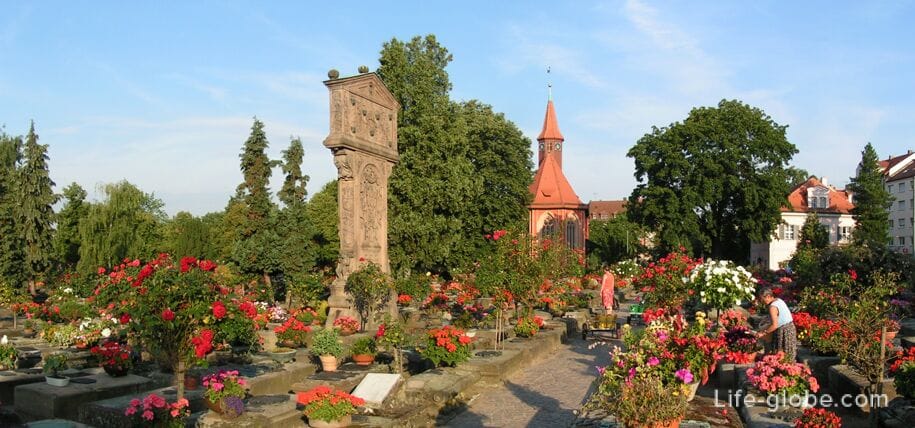
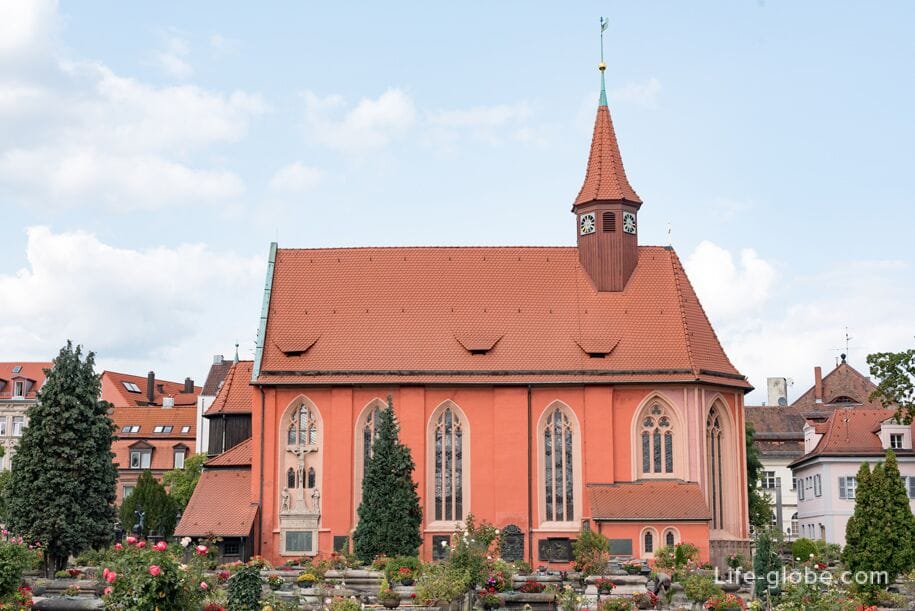
The Nuremberg Way of the Cross
The Nuremberg Way of the Cross (Nürnberger Kreuzweg), also known as the Adam Kraft Way (Adam-Kraft-Kreuzweg), is a kind of example of the way of the Cross of Christ and has seven locations in the city of Nuremberg, created by Adam Kraft in 1506-1508.
The sculptor made to order seven steles depicting the way of Christ to Golgotha and inscriptions. The path led from the city walls and ended with a huge crucifix in the cemetery of St. John. Now the crucifix is in the courtyard of the Hospital of the Holy Spirit, and the original Steles have been replaced with copies.
The 1st stele is located at Burgschmietstraße 6;
2nd - Burgschmietstraße and the corner of Weigelstrasse;
3rd - Burgschmietstraße, in front of Kunstgießerei Lenz Art foundry;
4th - Burgschmietstraße and the corner of Campestraße;
5th - intersection between Burgschmietstraße and Johannisstraße;
6th - Johannisstraße and the corner of Rohledererstraße;
7th - east entrance to St. John's Cemetery.
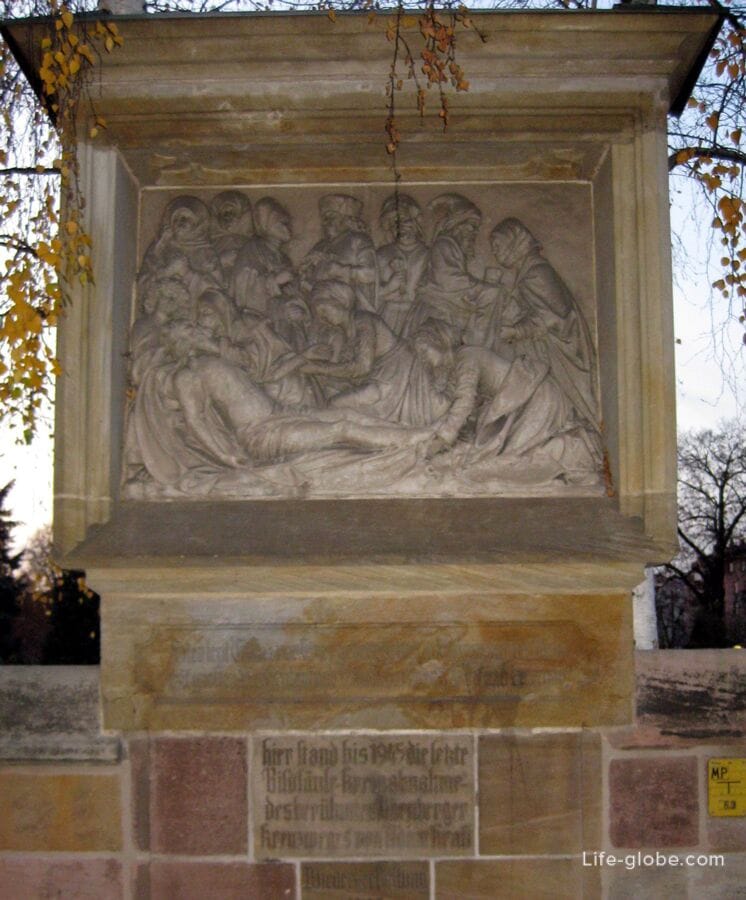
All accommodation facilities in Nuremberg, including in the historical center of the city and more remotely from it, can be viewed and booked here








